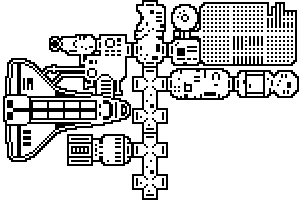|
 Earth Orbit Stations is a business sim IN SPAAAAAAACE! In it, you and up to three other players, be they human or AI, try to win one of seven missions, starting with learning how to build your first station. At first, your focus will be on profit, trying to predict market demand for various activities and building modules to meet that demand. In time, you'll begin to use those modules for research, unlocking more advanced modules and developing the ability to leave the comfort of Earth's orbit. When your first station no longer meets your needs, you'll build another, and another, until you have a veritable swarm of stations pumping out cash, analyzing data, or carrying cargo throughout the system. You'll create colonies on the moon, in space, and eventually throughout the solar system, on your last and most important mission - the search for extraterrestrial life. The game looks intimidating at first glance. The user interface isn't the best; it predates modern UIs and could really benefit from a mouse. Among other issues, it's easy to accidentally place a station module in the wrong spot, and there are no take-backs. Once you get past that, you face the challenges of designing stations that do what you want and predicting the vagaries of the in-game market. And of course your rivals are all doing the same thing. That said, it's not as bad as it looks. If you think you might be interested, keep reading. Berryjon and I play the first mission together, learning the ropes along the way and making lots of mistakes (especially on my part), and by the time you get caught up, you should have a good idea how to play. (And if you don't, just ask!) You can get the game manual here, and I'll have the programs I use to assist my play up on Google Drive as soon as I've polished them enough for public consumption - minus things like 'how to predict the market', of course. FredMSloniker fucked around with this message at 20:47 on Jun 7, 2021 |
|
|
|

|
| # ¿ May 22, 2024 12:25 |
|
 The last page of the manual has images of all station modules, showing their size and attachment points. Individual images are also linked below. Basic Station Modules:
Activity Modules:
Cargo Modules:
Modular stations are built by choosing an orbit (the default is Low Earth Orbit), then connecting station modules together until the station does what you want it to do. The station class is determined by what modules it has:
FredMSloniker fucked around with this message at 18:52 on Jul 15, 2021 |
|
|
|
 EOS was published for both the Commodore 64 and the Apple ][. I considered LPing the latter version, but the graphics are largely inferior and I'm more familiar with the C64. Plus, with emulation, I don't have to deal with the 1541's criminally slow speed. Fun fact: EOS for the C64 has a... shall we say, novel? Method of copy protection. Specifically, if it fails its protection check, after every single sector it reads from the disk - no more than 254 bytes - it resets the drive head to its central position. Not only does this make loading excruciatingly slow, it's a good way to destroy the drive. Anyway, I got to look at this particular animation a fair amount in my youth. Most of the Electronic Arts games used it. 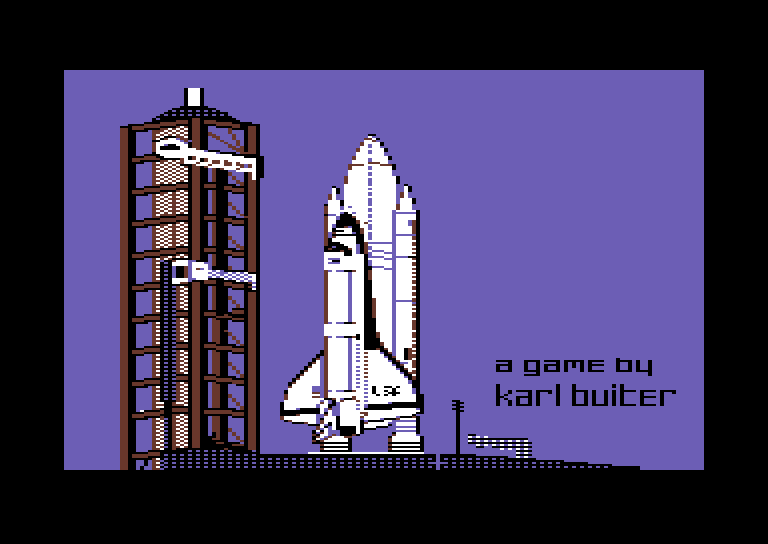 EOS was published in 1987, just one year after the Challenger disaster. The Space Shuttle fleet was grounded, and would continue to be grounded until September of 1988. That said, the optimism of using the Shuttle wasn't unfounded; the shuttle program ran until 2011, despite the loss of both the Challenger and the Columbia (in 2003). 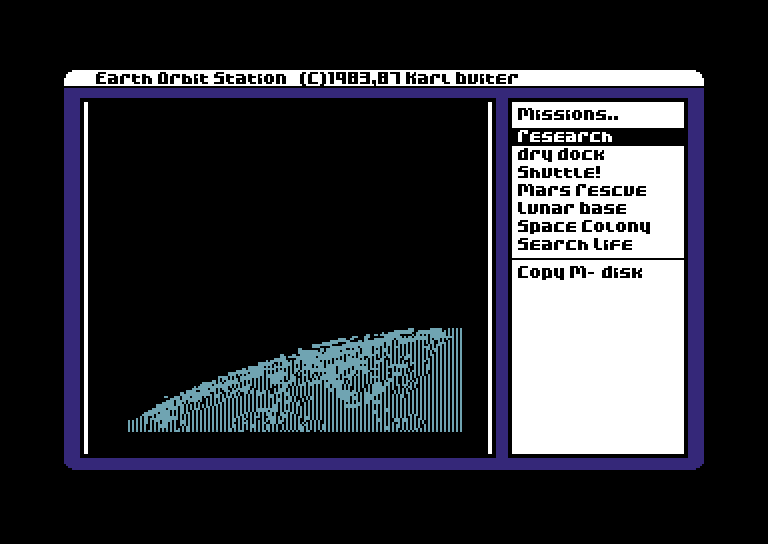 If the Earth and the EA logo look strange, it's probably because they're directly ported from the Apple ][ version. The Apple ][ had a bizarre way of displaying multiple colors that involved such mysteries as storing seven half-pixels in a byte and not being able to have a green pixel and a purple pixel horizontally adjacent to each other. It makes the title screen look like this:  The C64 has its own graphics limitations and can't cram a bunch of colors quite that close together. On the other hand, it has more than six colors to use and a larger resolution, especially horizontally. I prefer the sharper images.  There are seven missions in Earth Orbit Stations. We'll be starting on the first one, Research. When we start a new mission, we get a welcome message from the director of the Federation... 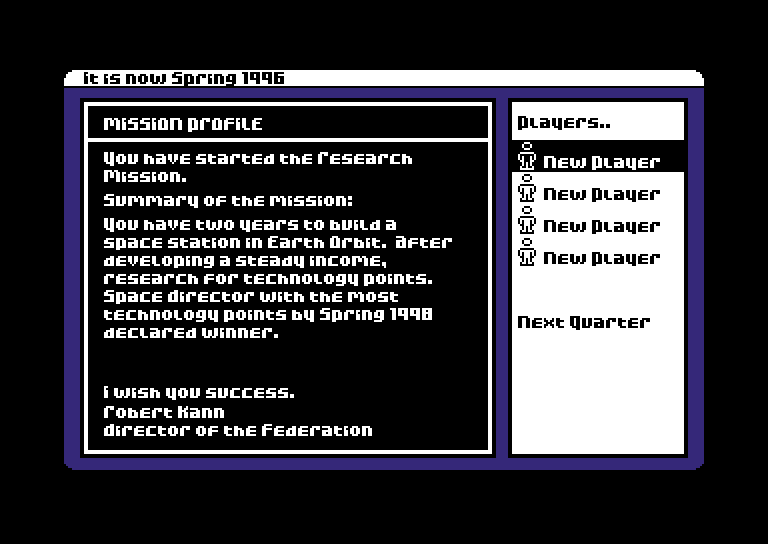 ...followed by a summary of the mission objective, which is also described in the manual. 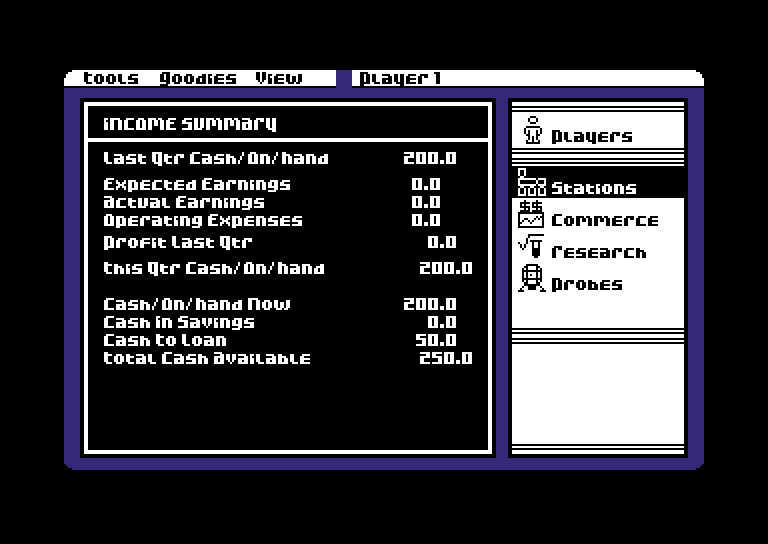 We're then asked to create a player. We can have up to four players, be they human or computer-controlled. New players can be added at any time, but not removed. I went ahead and created a character so I can show you some pertinent bits of the interface. (The interface as a whole is kind of clunky, so I won't show you every single screen you'd visit during play.) 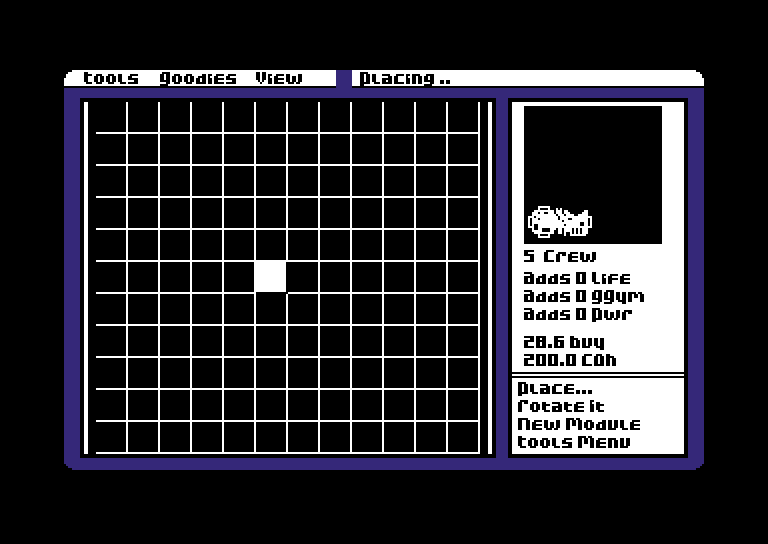 Your first station is a freebie, but to create more stations, you have to have paid back any loans from the EOS Bank (which I'll cover later) and have 250 credits on hand. (I don't believe you have to spend those credits, though of course you'll spend some of them on the new station.) At first, you can only create one station per quarter. In this mission, you'll probably only want one station, but the option to expand is there. Every station must have at least six modules: Command, Logistics, a source of Power, a source of Life Support (Life), a source of Galley & Gym (GGym), and a connector. These are the modules you'll use to meet those requirements:  Command: "Facilities for the Space Station Command team. Control, communications, and living areas are provided." Costs 25 credits to build, two shuttle tons to launch, and five credits to operate. Uses five crew. One of the two essential modules for station operation. It has its own power, living quarters, galley, and gym, but it does cost credits for upkeep.  Logistics: "Engineering centers including power distribution, life support, and medical unit." Costs 15 credits to build, two shuttle tons to launch, and three credits to operate. Uses four crew. The other essential module for station operation. Like the Command module, its only operational expense is money.  Station Power: "A small solar panel with power distribution equipment to supply power to the station." Costs ten credits to build, one shuttle ton to launch, and two credits to operate. Provides 35 Power. Station Power modules are the cheap and cheerful way to power your station. Three of them provide slightly more power than a Solar Connector at half the price, and each one is a quarter of the size. Operating costs will eventually make them inefficient, but short-term they're quite useful.  Solar Collector: "Produces power for the station and transmits excess power to facilities on Earth." Costs 60 credits to build, four shuttle tons to launch, and two credits to operate. Provides 100 Power. Provides Energy activity at a base charge of 20. The Solar Collector is an investment. It's four times the size of a Station Power module and only produces three times the power. However, it's slightly more convenient to place, needing only one attachment point, and its operating cost is the same as its smaller brethren; it pays for itself in two years. It can also be used for Energy activities (and is your only initial source for those), which Station Power cannot.  Life A: "Living areas for four mission crew. A lounge is provided for crew recreation." Costs ten credits to build, one shuttle ton to launch, and two credits to operate. Provides four Life; requires five Power to operate. The Life A provides half the life support of the Life B at half the size, making it slightly more convenient to fit into your station. Buying two of them will cost only slightly more than one Life B, both initially and in upkeep. That said, unless you really need exactly four more life support or need to squeeze into a 1x1 gap, there isn't much point in buying the Life A.  Life B: "Living areas for eight mission crew. A lounge is provided for crew recreation." Costs 18 credits to build, two shuttle tons to launch, and 3.6 credits to operate. Provides eight Life; requires ten Power to operate. The Life B is your workhorse for life support generation until you unlock the Life LH2. It's compact, it has two attachment points, and it's big enough for a game of zero-G volleyball.  Galley & Gym: "Galley and food storage facilities for 24 mission crew members. A gym is used for crew conditioning." Costs 25 credits to build, two shuttle tons to launch, and five credits to operate. Provides 24 GGym; requires ten Power to operate. Other modules technically provide GGym, but this is by far the most cost-efficient. The rotating section lets you recreate the jogging scene in 2001.  Short Connector: "A small tunnel section used to connect up to four modules together." Costs five credits to build, one shuttle ton to launch, and one credit to operate. Every station needs at least one connector, and most require more. The Short Connector provides just enough additional attachment points to build a station with two Station Power and a single research or commerce module.  Long Connector: "A long tunnel section used to connect up to six modules together." Costs eight credits to build, two shuttle tons to launch, and 1.6 credits to operate. Most of the time you're going to want stations larger than the bare minimum, which means more connectors. The Long Connector costs 20% less than two Short Connectors both to buy and to maintain, with only a tiny sacrifice in flexibility. 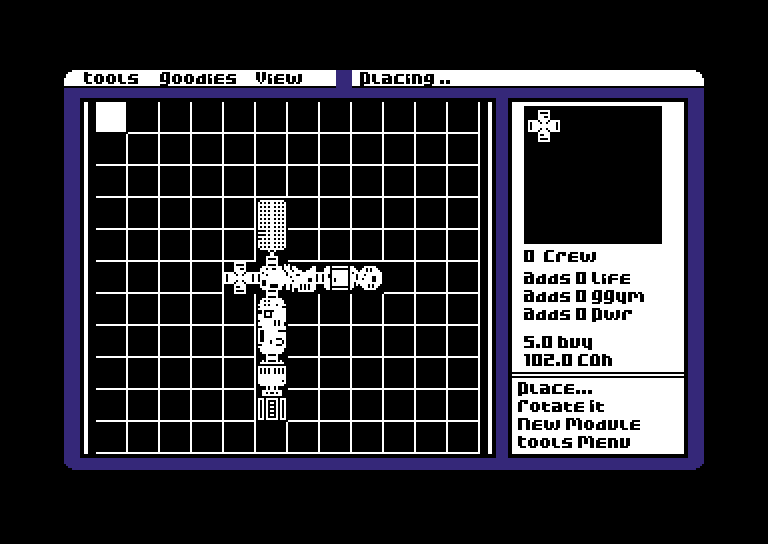 This is a station that meets the bare minimum requirements to be a functional station. Note the 12x11 grid. Your station must fit inside the grid, but if you discover you've built too close to an edge, you can slide it around. Modules can be rotated in increments of 90 degrees, but not flipped. All modules after the first must connect to another module; the attachment points are shown by arrows in the images above. This isn't a very useful station right now; all it does is consume credits. (We could make some of the modules inactive to save on upkeep, but not all of them.) To do more, we need modules that provide activities. Modules that provide activities can be set in one of two modes: commerce or research. (They can also be set inactive to save on upkeep.)  This is an overview of the demand for modules in commerce mode to provide activities. They're colorcoded based on changes in the market, but to see the actual demand, you need to look at each one individually. The market as it stands is:
By the looks of it, Pharmaceutics and Medical activities are a good place to put our money, and Resources, Forestry, and Biology activities... are not. But how do we get at that money? Well, we add some of these modules:  Building Platform: "Construction facility in space. It has a crane to assist astronauts in building large structures." Costs 34 credits to build, two shuttle tons to launch, and 2.5 credits to operate. Uses two crew. Requires 20 Power, two Life, and two GGym to operate. Part of the Construction Base. Provides Construction activity at a base charge of 26. Your sole initial source for Construction activities. When people want stuff built in space, it gets built here.  Chemical Lab: "A laboratory for scientists involved in chemical research." Costs 26 credits to build, two shuttle tons to launch, and 2.5 credits to operate. Uses three crew. Requires ten Power, three Life, and three GGym to operate. Part of the Science Lab Station. Provides Sciences and Materials activities at a base charge of 18. This module is the sole initial source for Materials activities and provides Sciences activities as a bonus. Watch your head on the fume hood.  Communications: "A transmissions module that receives/sends signals between Earth and space stations." Costs 36 credits to build, two shuttle tons to launch, and 2.5 credits to operate. Uses one crew. Requires 20 Power, one Life, and one GGym to operate. Part of the Communication Base. Provides Information, Communications, and Entertainment activities at a base charge of 16. Your initial source for, well, Communications activities, and your only source ever for Entertainment activities. The Information activities are gravy.  Computer Lab: "A laboratory for scientists involved in semiconductor research." Costs 40 credits to build, four shuttle tons to launch, and four credits to operate. Uses four crew. Requires 20 Power, four Life, and four GGym to operate. Part of the Science Lab Station. Provides Information activity at a base charge of 31. While not your only source for Information activities, this module is significantly more effective than the Communications module. This is one of two activity categories you never research better modules for.  Pharmaceutic Lab: "A laboratory used to study and produce exceptionally pure pharmaceutical products." Costs 32 credits to build, two shuttle tons to launch, and 2.5 credits to operate. Uses three crew. Requires ten Power, three Life, and three GGym to operate. Part of the Life Sciences Station. Provides Pharmaceutics and Medical activities at a base charge of 20. Your sole initial source for Pharmaceutics activities, and your only practical source for Medical activities. (The Space Hospital module, while it does provide Medical activities, is best used for its cargo function.)  Resource Platform: "Resource Platforms provide equipment for manned study of Earth's resources." Costs 21 credits to build, two shuttle tons to launch, and 1.5 credits to operate. Uses one crew. Requires ten Power, one Life, and one GGym to operate. Part of the Life Sciences Station. Provides Resources, Forestry, and Agriculture activities at a base charge of ten. One of only a few modules that provides three activities, and your sole initial source for Resources activities. 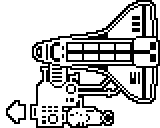 Shuttle Port: "Shuttle Ports provide facilities to dock a shuttle to a space station." Costs 77 credits to build, four shuttle tons to launch, and 9.5 credits to operate. Uses five crew. Requires 70 Power, five Life, and five GGym to operate. Part of the Transport Base. Provides Transport activity at a base charge of 74. An expensive module to build and operate, the Shuttle Port is your only initial source of Transport activities - but its rewards, both in commerce and in research, are equal to its costs. Go all in on this, or don't go at all.  Space Telescope: "A laboratory for scientists involved in physics and astronomy research." Costs 37 credits to build, four shuttle tons to launch, and four credits to operate. Uses four crew. Requires 20 Power, four Life, and four GGym to operate. Part of the Science Lab Station. Provides Sciences and Physics activities at a base charge of 27. One of two initial sources for both Sciences and Physics activities. Physics is the second activity you'll never research a better module for. Note: abbreviate this "SpacT".  Weather Center: "Advanced, manned weather forecasting facility capable of monitoring Earth's weather." Costs 17 credits to build, one shuttle ton to launch, and 1.5 credits to operate. Uses two crew. Requires five Power, two Life, and two GGym to operate. Part of the Science Lab Station. Provides Physics and Agriculture activities at a base charge of ten. While this module doesn't provide anything unique, it is very cheap to own and operate, and it's positively minute. All you need is an unoccupied connector. Note that we have no way of generating Fabrication or Biology activities - we'd have to research advanced modules, which is out of the scope of this mission - so we don't need to worry about those markets. Here's your cheat sheet for how we can generate activities:
 Perfection. (Note: not guaranteed to actually be perfection.) 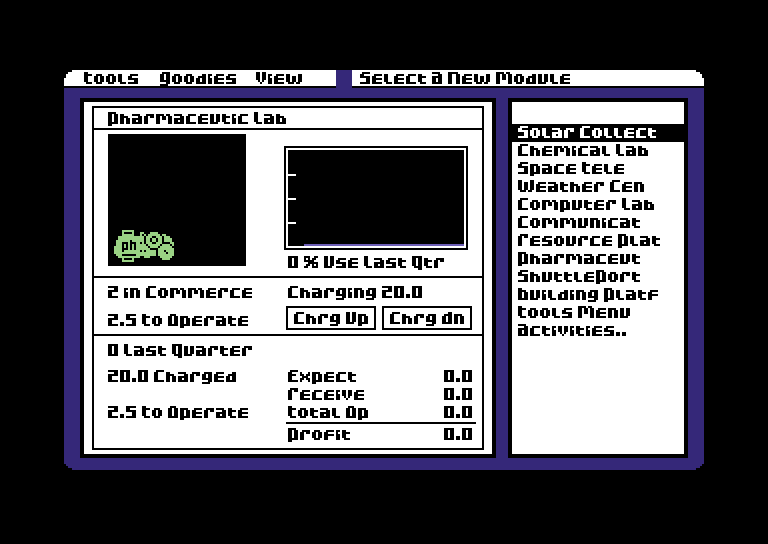 There's one more thing we need to worry about. In the module descriptions above, I mentioned a base charge. Each module that produces activities has a base amount that you can charge the market to provide those activities. This assumes a demand of 200. If, say, the demand is 400, you can probably get away with charging twice as much for that activity; if the demand is 100, you're probably going to have to charge half. The amount your module actually earns is determined by the percentage usage, which is influenced by market demand, the prices other players charge, and other factors outside the scope of this mission. Based on the current demand for Pharmaceutics and Medical, therefore, I'm going to try charging... 25.2 credits for people to use each of my modules and see how it shakes out. 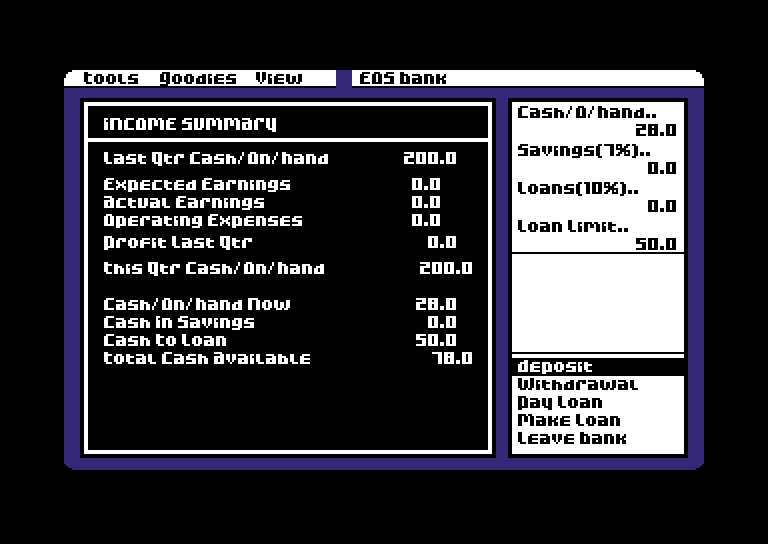 With that done, I only have 28 credits on hand. I could take out a loan to finance additional construction, and maybe it'd be a good idea. Instead, though, I'm going to drop my remaining cash in the bank to earn interest; I'm confident that my shiny new Pharmaceutical Labs will more than pay the rent on the station. That's me done - for the moment. Players can take actions in any order, and can even take more actions after other players have done their thing. Time doesn't advance until the players agree to move to the next turn. So I could decide to take out that loan after all once you guys decide what to do. Speaking of players, it looks like we have one to compete with me and Space Platform International Technological Enterprises! Let me know what you want to do; you have 200 credits and are pre-approved for up to 50 more. (I realize it's tricky to describe how you want to build your station. I'm brainstorming ways to make it easier.) I believe I've covered all the relevant actions, but if you see anything in the manual that you're curious about, ask away! I'm going to be putting module descriptions in my second post, along with other relevant lore. For now, here's the EOS News, live via satellite:
Oh, and one last shot of advice from the manual: Research: Build a basic station and follow the market trends. Use commerce to grow as fast as possible for the first few quarters. At some point, put all modules into research. (The trick is: when?) Remember that the scenario only lasts 8 quarters, and that modules that affect several activities generate more technology points. Good luck! FredMSloniker fucked around with this message at 04:22 on Jun 2, 2021 |
|
|
|
I've put a bunch of information in the first two posts. The second is all from the most recent update; the first has info on the current game. Lemme know if you have any questions.
|
|
|
|
Kangra posted:I played Project Space Station a lot, and I always wondered what EOS was like, so I'm interested in following this. It's not that deep. My impression (again, largely blind) is that you focus more on designing efficiently laid-out stations, balancing commerce and research (later missions will require researching technologies to build more advanced modules), and keeping your ledger in the black and your station lights on.
|
|
|
|
I'm guessing a barrier for entry into this LP is figuring out how to share your awesome station designs with me without showing your art skills, or lack thereof, to the world with a scanned doodle. To that end, I'm providing three ways to simplify matters. Here's my sample station: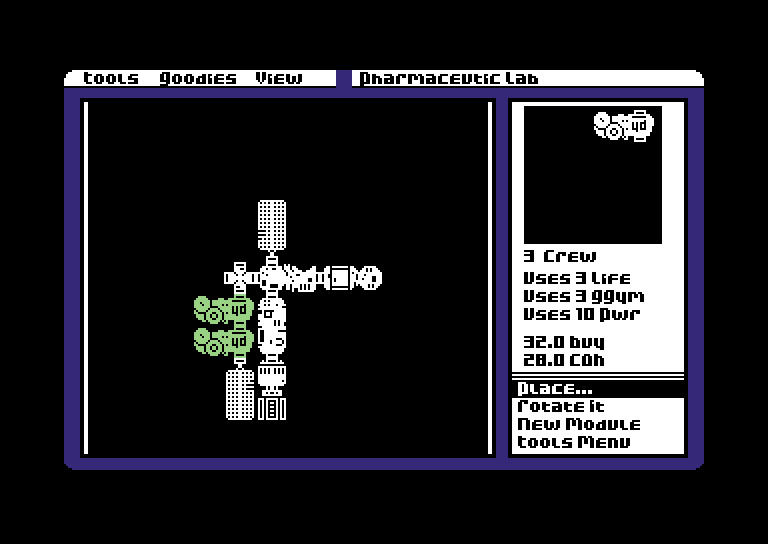 And here's how you can describe it to me, in increasing order of effort on your part:
If there's anything else I can do to entice you into taking part in this LP, please let me know!
|
|
|
|
berryjon posted:Canadian Space Arm-and-Leg Agency. "Where you don't have to pay what we have!" One of the unpaid interns scurries into the Director's office, holding a fax of the planned layout for CSALA's first space station and some scribbled notes. "Sorry to interrupt you, Director," he says, bowing apologetically, "but the folks in engineering say there's a problem with your proposal. The Solar Collector module's connector is here -"  "- and they say that would mean either plugging into the side of the G&G's airlock or into open space, which is... less than ideal? I asked them about flipping it over, but they said something about proper solar panel orientation, I'm not sure, it kind of flew over my head. They also said some of the ports on this long connector -" He gestures at the upper part of the diagram. "- are getting blocked by life support and logistics." He flips to the next page of the fax. "They had a few suggestions..." The simplest solution would be to flip your station on the horizontal axis. You'll need to move the Communications module, but that's a lot easier to do than moving the Solar Collector. You might also consider opening your layout a bit to keep those connectors unblocked and filling in the gaps on a later turn. At any rate, unless you change your module assortment, your proposed station will cost 195.0 credits to build and 24.3 credits per turn to run, with a combined base commerce income of 36.0. (You also forgot to say what price you were going to set for using the Solar Collector; its base charge is 36.0, and the current demand for Energy activities is 198.7.) It has a surplus of 60 Power, 7 Life, and 23 GGym. It has, at most, eight open connections, though two are currently blocked. Oh, and ANSI has declared that the abbreviation for the Galley & Gym is "Galle", capitalization optional. What that means to you in Canada I couldn't say. 
|
|
|
|
berryjon posted:Can you elaborate on how Income is calculated and when on the turn? Each module that you put into commerce mode (any module that generates activities can be put into either commerce mode or research mode) has a base charge, which is essentially what the game suggests you charge for the market to use that module if demand is 200. You can set the actual charge for any of your module types to whatever you want. When the turn advances, the market does its thing, and everybody's commerce modules get assigned usage percentages, how much of that module's capacity for commerce is actually used. This depends on the price you set versus demand, on what other people are charging, and some other factors; like I said, I'm going into this largely blind, so I'm not 100% on things like whether you building more modules may make you lose usage percentages as the market's demand runs out, how you should set prices if a module provides more than one kind of activity, and so on. You collect your income, (charge set) * (usage percentage) for each module, then subtract operating costs. As for timing, I know that you can pay operating costs out of the money you make on a given turn (so you can put all your money in savings if you're going to make a profit). I don't know what happens if your station is running at a loss and you run out of money, if it makes you take out a loan or you just lose or what. Also! I thought it might encourage people who are still uncertain about taking part if I shared some sample station designs. I started a new game with four AI players doing the Research mission and recorded their build as they went. (Note that their markets moved differently than ours did/will. This is just sort of a suggestion.) 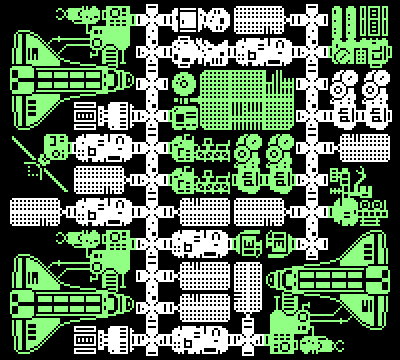 Player 1, Station 1  Player 3, Station 1 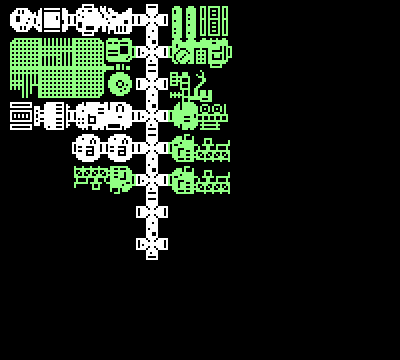 Player 3, Station 2 As you can see, players 1 and 3 had basically the same plan, but player 3 executed it more successfully, even being able to afford to build a second station at some point. (Green modules are modules that were producing income at the start of the last turn; all modules were switched over to research mode (white) at that point, as commerce no longer matters.) 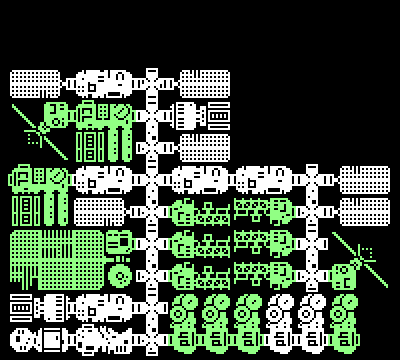 Player 2, Station 1 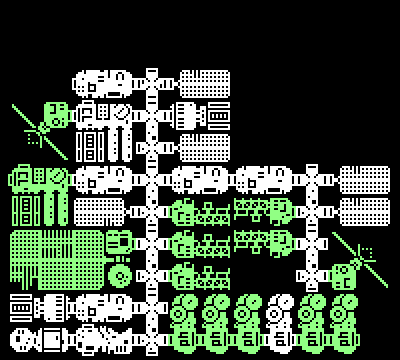 Player 4, Station 1 Similarly, player 2 executed its plan slightly more successfully than player 4. Despite the smaller stations, players 2 and 4 scored the same as players 3 and 1, respectively; I'll go into more detail near the end of the mission, but for now just know that research modules can play it safe or take chances. The one thing all four designs have in common is two vertical spines connected by modules with two connectors (1 and 3 start in the middle and link with Command and Life B, while 2 and 4 start in the lower left and link with two Life B). It's a layout that modules can pretty neatly pack into, and one I wish I thought of before designing my current layout. Also, something I did not know until just now: the Shuttle Port's hitbox is not 4x4.You can squeeze two tiles' worth of stuff in on the Shuttle's right side. That's the only module (including the ones we haven't unlocked yet) that's insufficiently rectangular for that to be possible, though. Also also! I know at least some people are reading this thread who haven't asked to take part. If there is anything I can do, within reason, to encourage participation, let me know! e: also also also! I changed the color settings in the emulator, so the images will 'pop' more. I'm going to cut the borders off of future screenshots as well unless someone has a reason I shouldn't. FredMSloniker fucked around with this message at 03:54 on May 31, 2021 |
|
|
|
I was trying to nicely format this update, but I kept running across annoyances; for some reason, the SA forums replace certain Unicode symbols with images. It's annoying that ☺ is and ☻ is not; similarly, ↔ is, but ↑ and ↓ are not. Eventually I did find some glyphs that'll work, knock on particle board. Here's the market, sorted current prices highest and marked with significant (10% or more) market changes, along with some information on what the activities are and how to generate them.
|
|
|
|
Also, at some point I goofed in an update and said the mission started in 1992. It starts in 1996, for whatever that's worth.
|
|
|
|
In attempting to figure out how I want to start my station, I'm remembering that Economics is Hard. I'll share my insights when I post my move, so you can benefit from them.
|
|
|
|
This is how I planned my turn. The Research mission has, roughly speaking, three phases. In the first phase, I want to grow my station's profitability as quickly as possible. In the second phase, I want to stop growing my station and accumulate credits. In the third phase, I want to switch my station over to research, keeping it running on the credits I accumulated. Ideally I should end my last turn broke, but having generated as much research as possible. Figuring out when to change phases will therefore be important long-term. For right now, though, my goal is growth. Each module that can perform activities has an operating cost, not just in credits but in Power, Life, and GGym (with the sole exception being the Solar Collector, which only costs money). In order to provide the Life and GGym, I need support modules, which have their own Power and operating costs. In order to provide the Power that these modules need, I need more support modules, which have their operating costs. All of this cuts into my profits from running the module. I can create a hypothetical module that needs no support, which I will dub a widget in honor of my long-ago economics classes, by calculating the fractions of support modules necessary to meet all of the activity module's needs, then add those fractions of purchasing and operating costs to the purchasing and operating costs of the activity module itself. Like many things in economics, this ignores certain realities in favor of simpler math, but it'll be useful for my purposes. If I only had one widget to choose from, my plan would be simple: buy as many of that widget as I can each turn. I have multiple widgets to choose from, though, so I have to consider which one will grow my station the fastest. (It's also worth looking at the next few options; diversification is a good idea.) So how quickly can I grow profitability with a given widget? That depends on three factors: the purchasing cost of the widget, the operating cost of the widget, and the income of the widget. The first two are known. The third I have to determine. I'll get into how momentarily. Let's suppose, as economists do, that we can buy fractions of a widget. If I have an amount of cash n and can buy widgets with a profitability of p and a cost of c, I can buy n/c widgets, which will produce p*n/c income. On my next turn, I can buy (p*n/c)/c widgets, but I still have the old widgets, so I earn p*n/c+p*(p*n/c)/c. If I keep this going and plug in, say, n=10, p=1, and c=2, I get: Turn 1: bought 5.0 widgets (I now have 5.0) and earned 5.0 credits. Turn 2: bought 2.5 widgets (I now have 7.5) and earned 7.5 credits. Turn 3: bought 3.8 widgets (I now have 11.2) and earned 11.2 credits. ... Turn 100: bought 451734641705794432.0 widgets (I now have 1355203925117383168.0) and earned 1355203925117383168.0 credits. This is what we, in the biz, call exponential growth. In 14 turns, I'm a thousandaire. In 31, I'm a millionaire. in 48, I'm a billionaire. Since I want to grow as quickly as possible, and I grow faster with a high p and a low c, I want to choose a widget with the highest p/c. I know what c is, and I can compute p; if I charge x to use the widget, which has an operating cost of o, p=x-o, so I want to maximize (x-o)/c. So charge an infinite x, you say! Not so fast. The market won't support that; the more I charge, the less module usage I get, which effectively lowers x. The point of this exercise is to figure out what x gets me exactly 100% module usage; if it's too high, I'll have unsold supply, and if it's too low, I'll have unmet demand. I do have some guides in finding the perfect x. One is the market demand for the activity or activities the module produces. Another is the base charge for the module, which is how much the game suggests charging if the market demand is 200. A third is the change in market demand; if it's gone up a lot this turn, it probably won't go down a lot next turn. How do you roll all this up into the perfect x? Well, if I knew that, I'd be a bazillionare on the stock market. But I have some ideas. How you come up with it is up to you. At any rate, based on my ideas, I can generate a p/c for each activity module, which tells me what I want to use. Interestingly, c/p is how many turns it takes to pay off the module's initial cost, so I can also look at it as finding modules that pay for themselves the quickest. If I were to charge the base charge for all modules, here's how the widgets would stack up: BPT Widget 2.04 Shuttle Port 2.27 Building Platform 2.66 Computer Lab 3.07 Space Telescope 3.15 Pharmaceutic Lab 3.17 Chemical Lab 3.33 Solar Collector 3.85 Resource Platform 3.87 Weather Center 3.92 Communications The lower the base payoff turns, the better. But of course I have to consider the market and what I can get away with charging; it'd also help if I knew what the market was going to do. After much twiddling, a function I wrote, semi-sarcastically called nostradamus, kicked out some results for me to interpret. In descending order of probablygoodness, they are:
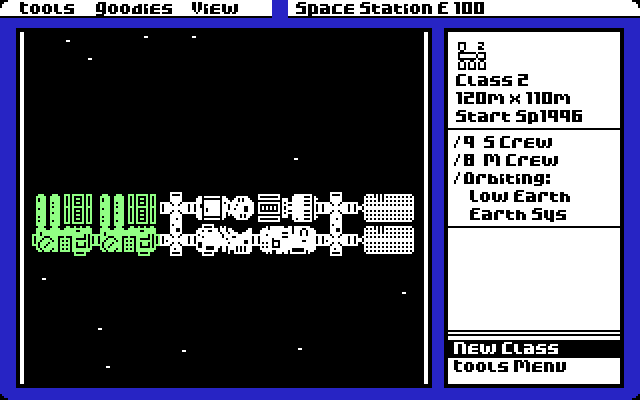 My station will cost 199.0 credits to build and 31.8 credits per turn to run, with a combined base commerce income of 62.0. It has a surplus of 10 Power, 0 Life, and 16 GGym. I can't afford to build any more of the top three money-makers and their support equipment, even if I take out a loan, so I don't. Instead, I set my module charges and put my last dollerydo in the bank. As for Berryjon's station, it's created as requested: 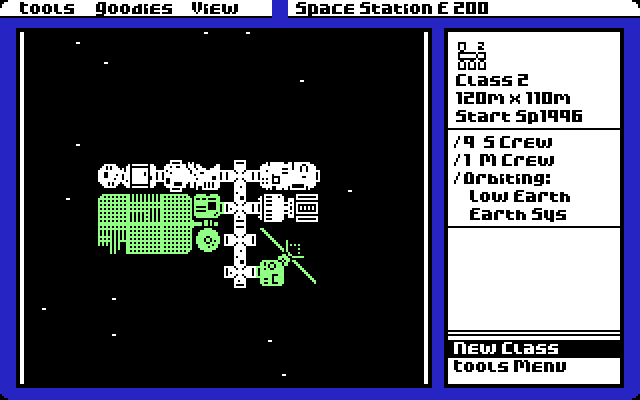 You'll be happy to know that you don't have to explicitly sell Power; the Solar Collector generates commerce or research independent of that, so you have a considerable Power surplus currently. You also can't specify which activity a module works on; I don't know whether that means you should use the best demand across multiple activities or the average demand to determine what you charge. Speaking of what you charge, are you sure you want to sell Energy at that rate? The current demand for Energy is 208.9, and the module's base charge is only 20. If it were me, I'd be charging about 20.9. But hey, I know as much as you do about how it works behind the hood... FredMSloniker fucked around with this message at 05:22 on Jun 1, 2021 |
|
|
|
ALSO! It has become clear to me why someone might be, say, hesitant to take part in the LP. I'm thinking that, for future missions, we may do more of a collab thing and try to beat the AI together. For right now, though, unless someone suddenly jumps up and waves their arm around: berryjon, do you want to add any AIs to the mix, or should it be just you and me?
|
|
|
|
berryjon posted:Let's just do round 1 between you and me, and a single AI to provide contrast to our designs. We'll see what happens in Round 2 and going forward. You got it! I'll make that change and add a third player, controlled by the AI. Then we advance into Summer 1996.  It looks like the AI has a couple of different blueprints that it just builds no matter the circumstances. We saw players 2 and 4 use this in the all-AI game, and it looks like player 3 was building a variant for its second station. 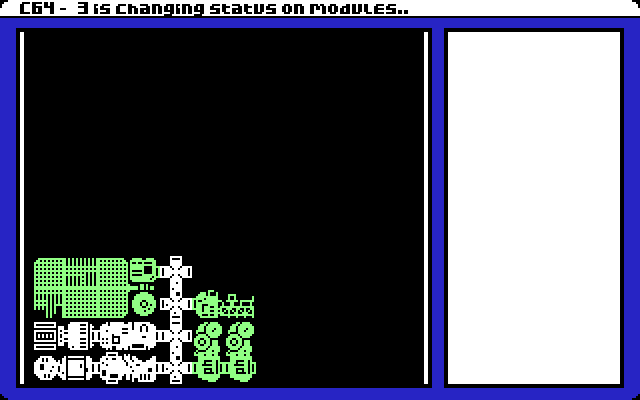 The color coding is as follows. White modules are either support modules or modules set to research; green modules are set to commerce; and blue modules are inactive for one reason or another. Right now the AI is commercing as hard as it can. 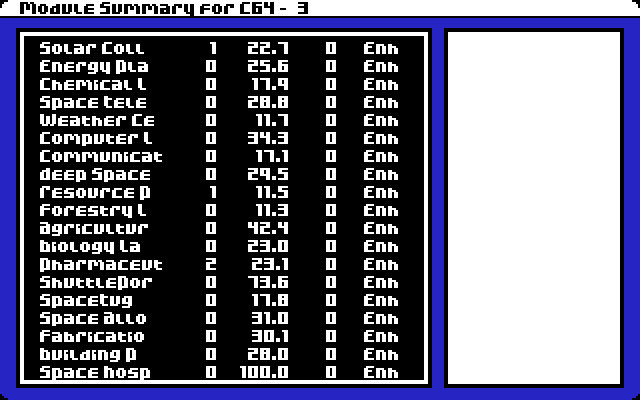 It's a pity you can't pause on this screen, because it has a lot of information in a tiny package. From left to right, the columns are:
 And now, the news. We start on this screen every quarter until it's time to determine victory. ...and then something strange happened. When I tried scrolling through the news, it started showing me news from Spring 1996. When I exited from the news, I suddenly found myself at a new game! I tried loading the save I made before going to the next quarter, but all our station modules had disappeared! And when I went to advance to the next turn, all of a sudden the AI already had all the modules it had built before and got to spend its money again to build new ones! ...and then I realized I'd accidentally opened a second instance of the emulator. Whoops! Unfortunately, two instances writing to the save disk got things somewhat, shall we say, confused. I'll be more careful in the future. Unfortunately that means restarting the game... again. So! The new news:
The new economy:
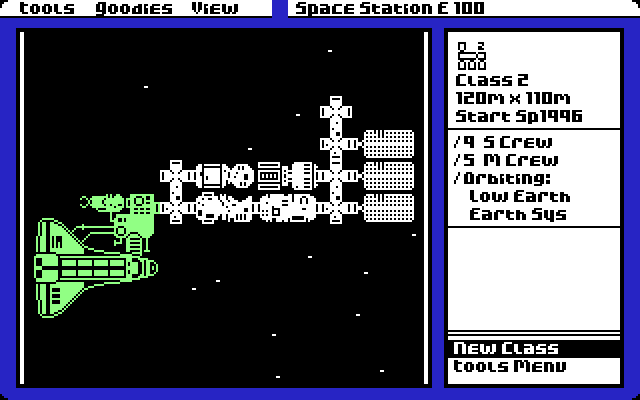 I'm going to charge 76.4 to use the Shuttle Port. I had to take out a loan to get this all in place, so hopefully it's worth it! Berryjon, given the new market information, do you want to change your station design? FredMSloniker fucked around with this message at 05:23 on Jun 1, 2021 |
|
|
|
Veloxyll posted:So is each mission self contained? Or do you play the same company throughout all of the missions? Because I can see tanking the first mission to win harder later on with your disgusting economy seems like it'd be a legit strategy No, the missions are self-contained. That said, the skills you pick up in the first mission will still be relevant in later ones.
|
|
|
|
I don't think Rightload likes you, berryjon: every image starting with your name that I tried to upload threw an access violation. The files did upload, though, which is how you can see: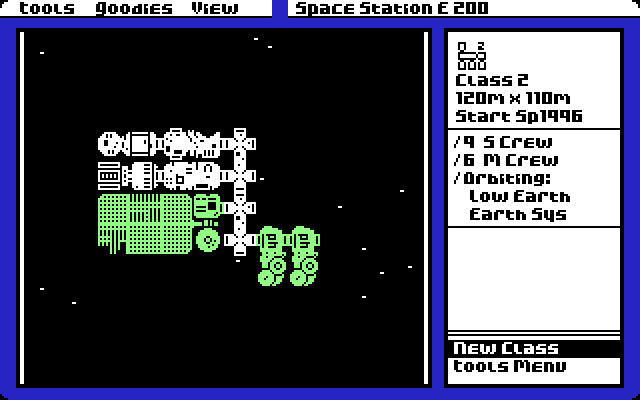 berryjon posted:"Yes sir. And the S.P.I.T.E station?" The public relations department of Space Platform International Technological Enterprises would like to remind the public that the proper usage of the business's acronym is "SPITE". "S.P.I.T.E." makes them sound like a supervillain's evil organization. And frankly, if anyone's going to use some sort of microwave laser to scorch the earth, it'd be those other guys, we're looking at you, mister "beaming safe and renewable solar energy". Ahem. Anyway. Save disk and save state backed up, we proceed into the next quarter. 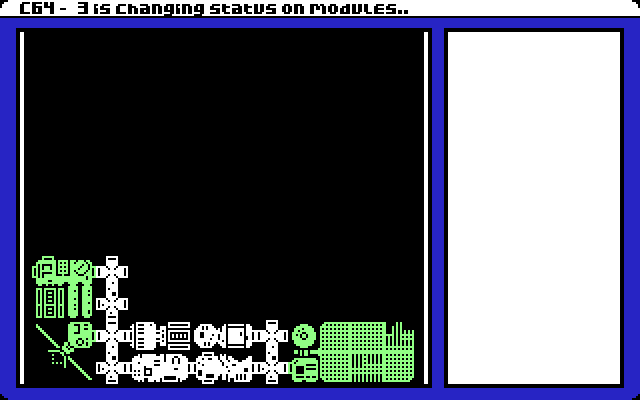 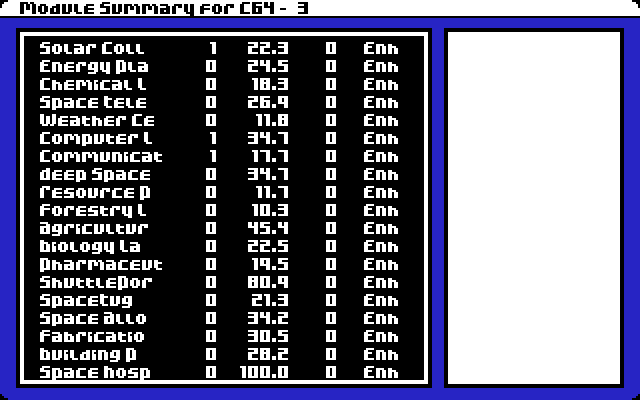 It looks like the CPU agrees with us on what we should charge for the Shuttle Port and the Solar Collector, but it doesn't think much of berryjon's investments in Pharmaceutics Labs. Let's see who was right. But first, the news:
Third, I was naively predicting markets would do pretty much the same thing this quarter that they did last quarter. This was true in most areas, but the Forestry market took a bath this quarter, erasing half its gains from last quarter. Construction also had a reversal of fortune, but a small one. Now that I have more market data, I can make a slightly more sophisticated blind guess this quarter. Let's see what this means for us in particular. 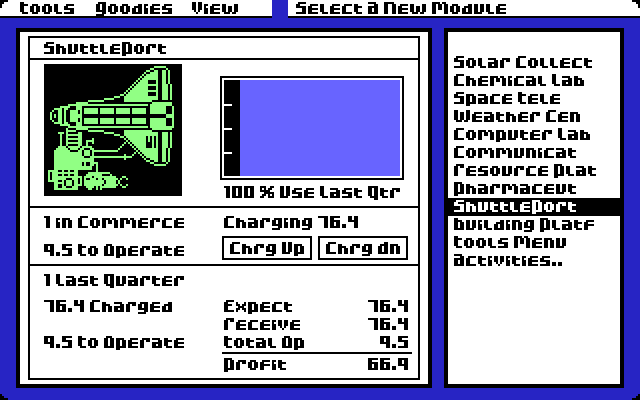 Getting 100% usage out of my Shuttle Port isn't as good news as it could be. It means I could have charged more. Ideally I want the usage to be right around 99% or something. 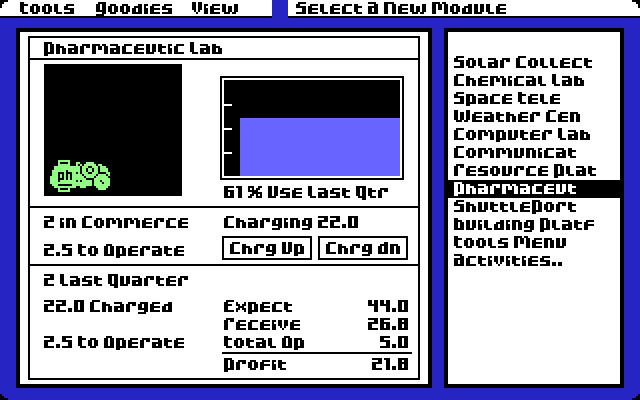 That said, whatever berryjon saw in the Pharmaceutics market, it didn't materialize. He didn't lose money or anything, but this is a hit to his financials. (The Solar Collector got 100% usage.) 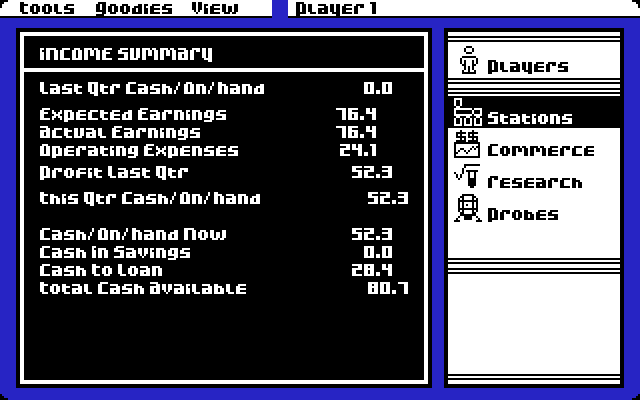 My finances... 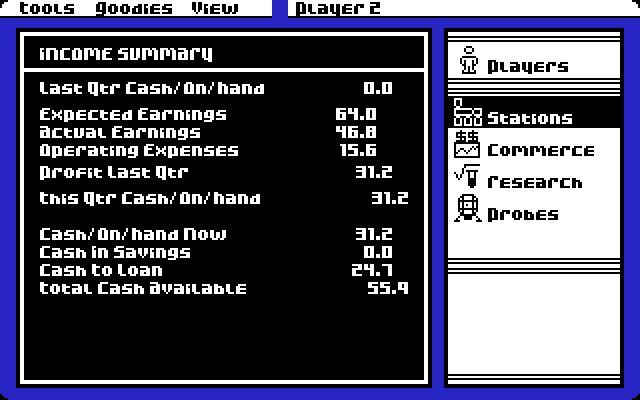 ...and his. (We can't see how the AI is doing, at least not directly; we can see who's winning, but in this mission that's 'no one', since no one's generated any research yet.) I'm going to take some time pondering my next move at let him work on his.
|
|
|
|
I have 80.7 credits to work with this quarter, counting what I can take out loan-wise, and three turns' worth of market information (counting 'turn 0'). I also have the news events, but I'm not sure what they're worth. The first turn's potentially relevants news events were:
 Successfully predicting the stock market, as I said, is something I could become a bazillionaire by doing. On top of that, I only have a few data points, and I won't have much time to get more, so I can't use a lot of the fancy tools economists use. That said, the market did more or less what I expected with the sole exception of Forestry, and I didn't see any warning there, so I'm not going too far wrong. This time, though, I'm going to consider how reliable my predictions for this turn were and be cautious about investing in anything whose reliability is too low. I want proven winners, for whatever value of 'proven' can apply with this little data. Admittedly, 'too low' is subjective given that most of my prediction errors were less than 1%, but it's something. With that in mind, and with a desire to diversify, and with some more napkin doodles, I bring you...  I'll be charging 36.7 for my brand new Computer Lab and raising my Shuttle Port fees to 81.3. LAN parties in space aren't cheap. Let's see. Game saved, emulator save stated, emulator closed, both save disk file and emulator state copied... right. Your move, berryjon. ...and I see you've made it while I was preparing this update. Right. I'll process it in the morning to reduce the chance of sleep-deprived goofs. And I'll throw in a little something extra for the crowd (or at least for you). e: and since I had to fix a typo anyway, in case it helps your future planning, here's a list of the activity modules we have access to by the number of activities they provide:
FredMSloniker fucked around with this message at 06:47 on Jun 2, 2021 |
|
|
|
The game allows you to trade modules, tech points, and cash with other players. Well, I say 'trade', but really it's a gift, and it's up to them not getting punched by you to give you whatever you asked for back. Tech points are how we win, so obviously that's off the table, and you can only trade modules when the optional shuttle rules are on (so I'll get into that in the third mission, conveniently titled "Shuttle!"), but if in future berryjon wants to take out a loan at the Bank of Fred, or vice versa, that's an option. (I don't know if you even can give something to the AI, but it's not going to give you anything back.) That said, since he'll have already tapped out the EOS Bank's 10% interest per quarter, well. Are you acquainted with our state's stringent usury laws?  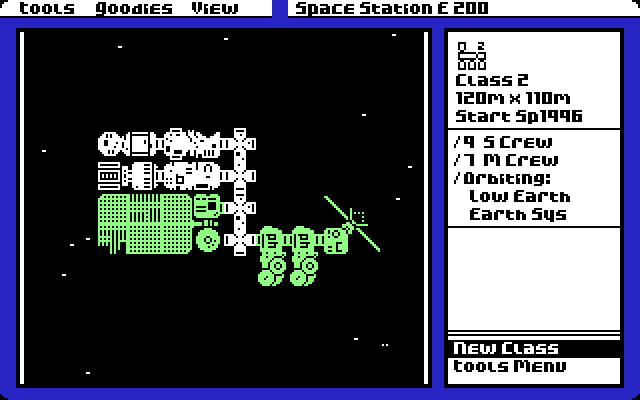 Here's his move (seriously, did you insult someone somewhere? I'm gonna have to start calling your files something else to see if Rightload stops complaining about uploading them)... 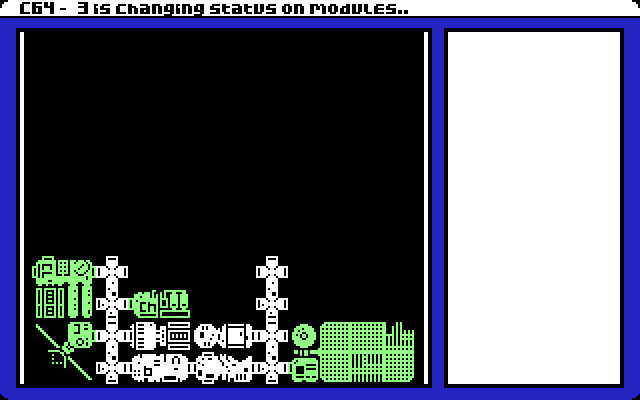 ...and here's the AI's. 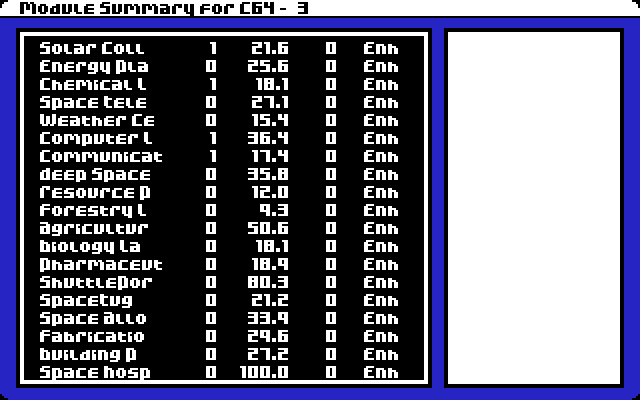 Leaving out the seemingly irrelevant market news (though if you want it, just say), there are only two points of interest. The first is that the cost of buying a Solar Collector has gone up to 66.3. The second is, well... 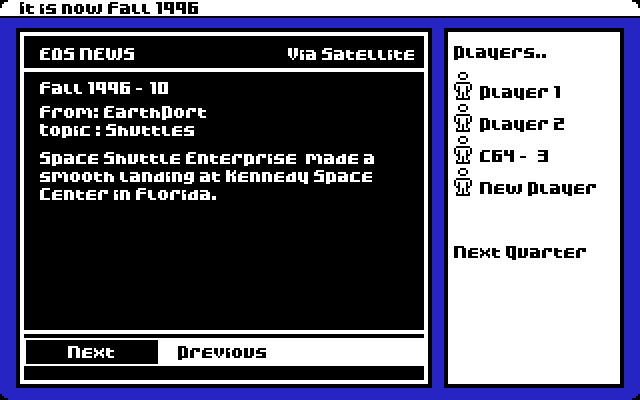 I was going to make a joke about someone on the dev team failing a research check, but it turns out that, after the Challenger disaster (which was when this game was made), NASA did consider retrofitting the Enterprise to actually fly. Ultimately, however, they built the Endeavour from spare parts. Anyway! Here's the market:
Fortunately, none of those surprises affected me. My Computer Lab module got 98% usage, and the Shuttle Port got 97% usage, which is great! It means my predictions there were spot on. As for berryjon, his Pharmaceutic Labs only got 77% usage as the market continued to tank, but his other modules saw 100% usage. It may be worth noting at this point that you can turn modules off, which saves their operating costs. That said, the Pharmaceutic Labs aren't actually costing you money - you made 22.7 credits off the both of them - so you'd probably only want to do it if the savings (five credits, three Life and GGym, and ten Power each) meant you could bolt something else on that you otherwise couldn't support. My move. I have 89.9 total cash available. Based on my predictions, and in deference to your RP needs, I bring you...  "Did you see the spike in agriculture demand? We need to get into that market, and we need to do it now," a minion said, waving a sheaf of papers. He was dressed in SPITE's business uniform, a deep blue jumpsuit with yellow trim, his ID card clipped to his chest. "But, sir," a second minion said, this one gesturing at a clipboard, "we're only just keeping up with the demand for on-station LAN parties! We can't afford a second Shuttle Port, but with another loan from the EOS Bank, we can easily add a second Computer Lab module. And the Weather Center's form factor is terrible!" Fred M. Sloniker, CEO of SPITE, frowned as he considered his options. He wore a loose-fitting jacket of the same blue and yellow-trimmed design of his minions' uniforms, but underneath it was a long-sleeved turtleneck in a more vibrant blue. He absently pushed his tinted glasses up his nose, then folded his white-gloved hands in front of his face, resting his elbows on his desk, his frown visible more in his eyebrows than in his mouth. The two men fell silent immediately. Then, after a long moment, he looked up at them, the angle no longer reflecting the ceiling lights off of his glasses, and offered a smile that could be better described as a lack of frowning. He spoke softly, but they hung on every word. "Why not both?" 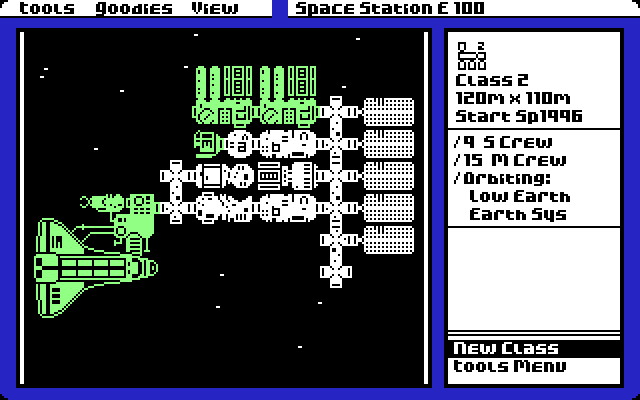 I'm charging 21.1 for the Weather Center, 84.0 for the Shuttle Port, and 38.8 for each Computer Lab. Berryjon, you have 64.5 cash available and a surplus of 40 Power, 1 Life, and 17 GGym. Go.
|
|
|
|
Kangra posted:For some reason I think PSS had a refitted Enterprise orbiter as well, though I may be misremembering. Don't forget the minigames. (I haven't actually played PSS, but I have read the manual, and I see you launch and land the Shuttle and do EVA activities.) But yeah, it's definitely got a different focus than EOS. I'll probably LP it too at some point. Berryjon, I'm waiting on you.
|
|
|
|
Kangra posted:I like that EOS has the space station design be something it looks like you can optimize for a particular type of research. Although it's not clear to me if in the long-term you'd be better to try and fill a niche or react to the way the tech economy is moving. Most activity types unlock new modules when researched. Some of these modules produce more of those or other activities, while some are requirements for specific missions - there are several modules to unlock before you can establish a lunar base, for instance. The only activities that are only good for selling (or generating arbitrary 'research points', like in this mission) are Biology, Entertainment, Information, and Pharmaceutics. In every mission, you're going to be following the money to some extent, but in several missions you need to unlock modules to win, which means you'll be building modules that provide the necessary research. You can have up to 32 stations, so you can devote some to research, some to commerce, some to whatever if you want. There are synergies to building stations with modules with things in common; I haven't covered that yet, as you pretty much have to devote a station to a bonus to get it, but I can talk about it in the next update or at the start of the next mission, whichever you prefer. berryjon posted:I'll get back to you in the morning. That's the thing, though. It accepted, say, "C64 Modules Turn 2.png" just fine. Actually, lemme do some experimenting real quick... *click click click type drag click type click* ...okay, that's really weird. It looks like, if the string 'erry' appears anywhere in the file name, it causes the Rightload plugin to choke. The file uploads, but it gives an access violation error. That's going to tech support...
|
|
|
|
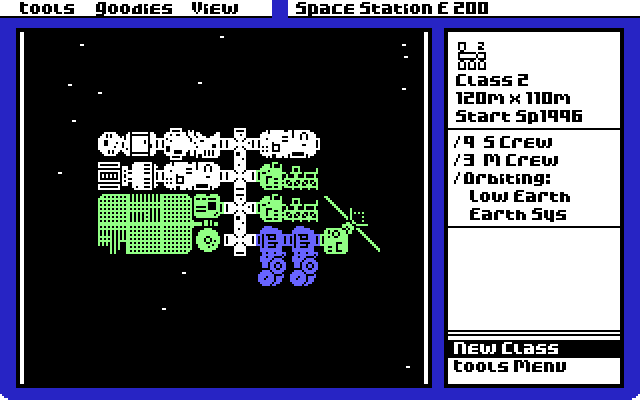 Berryjon makes his move. I admit, I'm not sure why he switched off the Pharmaceutic Labs - I would have charged 14.4 for them, which would still make a profit, and he didn't build over his maintenance costs - but hey, it's his call.  The AI doesn't do all that much. 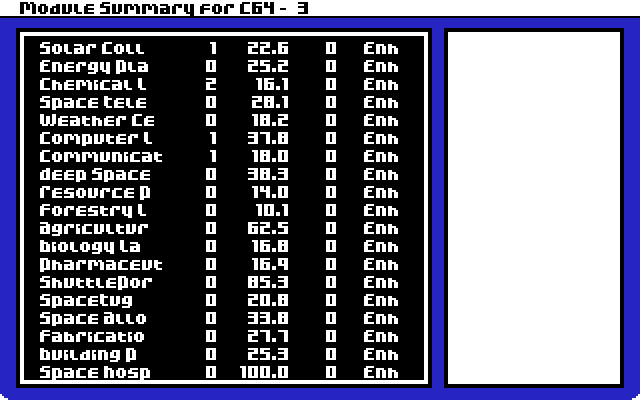 Comparing its demand predictions to my own, I note the three biggest outliers: it's much more pessimistic about the Weather Center and Resource Platform demand than I was, and, bizarrely, it's much more optimistic about the Pharmaceutic Lab demand than I was. Let's see how that shakes out. But first, the news:
Weather Center usage was 100%, Computer Lab usage was 96%, and Shuttle Port usage was 100%. Not bad, but could be improved. I'm moving to a new market prediction method this turn, and we'll see how it works out for me. (Incidentally, if we decide to stay competitive in the next mission, I'd be happy to share the code I use to decide what to build and what to charge - with the exception of the market prediction function. If you can figure out what the market's going to do, you put in the numbers and it'll spit out its suggestions.) And speaking of market predictions, berryjon got 100% usage on all modules... which leaves him with 50.3 available cash this turn. After paying my loan down to its limit (I discovered that interest can cause your loan to exceed its limit; no word on whether Li Yuen will send hostile shuttles after me if I don't keep it under control, and a secret bonus point to whoever gets that reference), I have 134.6. Therefore! In the interest of keeping this game even slightly competitive, I offer berryjon this generous offer: Fred looked dispassionately at the report on the CSALA station. By any measure, the company was doing poorly. They'd gambled on the pharmaceutics market and lost, hobbling them right out of the gate. The SPITE station was larger, more profitable, and almost certain to win the lucrative contract that awaited whoever was able to create more valuable research after two years. They'd won already, he felt; it was just a matter of time compounding his current advantage. And yet. What was better for society as a whole? One station producing incredible breakthroughs while another struggled to put out scraps? Or two stations, each producing solid growth? His decision made, he tapped a few buttons on his desk's built-in console, connecting a call to the director of CSALA. (That the director of CSALA might be uninterested in taking his call, or indeed that the director of CSALA might have to press a button to take his call, was irrelevant.) "Berryjon?" he said, mildly, his face appearing on every monitor in the other director's office. "This is Fred Sloniker, of SPITE." He pronounced the letters individually. "I have a proposition for you." Berryjon, I will loan you up to 134.6 credits at the same interest rate (10% per quarter) that the EOS Bank does. I will expect full repayment in two turns, but you can make a partial or full repayment next turn. Do you wish to accept this offer and, if so, how much will you borrow? Oh, and make your move while you're at it. FredMSloniker fucked around with this message at 19:38 on Jun 3, 2021 |
|
|
|
berryjon posted:Having this would help immensely. Whoops! Here you go. 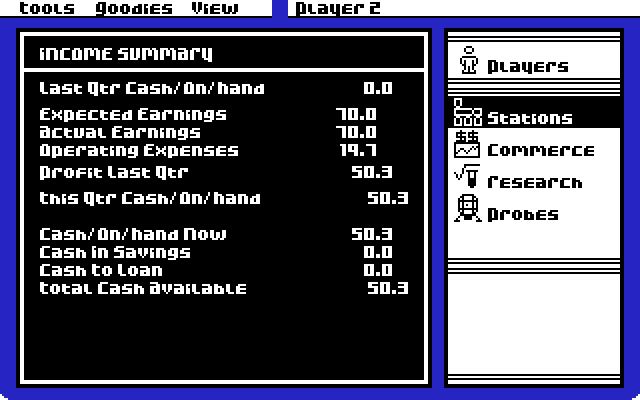 berryjon posted:Let me think this over, but I think I'm not gonna pull out of this spiral without some serious luck. Your gamble on Transportation paid off, that's for sure. Well, if you'd rather concede and just move on to the next mission, I can do that. My aim is for people to enjoy the LP, and if you're not enjoying...
|
|
|
|
berryjon posted:But I do enjoy learning, and as such, I could sandbox for the thread while you push ahead, that won't be a problem. Well, if you wanna keep playing, the loan offer stands! If I lose because of it, well, that's on me. berryjon posted:Also, how is loan repayment handled? To the EOS Bank? It's not automatic; your debt to the Bank increases each quarter, as appropriate, and you repay them from the EOS Bank menu. To another player? You send them cash when they say so to avoid the face punchings. 
|
|
|
|
Here's my turn. Based on my new market model, as well as my assumptions about how activity demand maps to module demand, nostradamus calculated a module charge to use, how long it would take to pay the widget off (as a reminder, a widget is a hypothetical combination of an activity module and the necessary fractions of support modules needed to run it), and how reliable the prediction is (essentially, how good was I at predicting what happened this turn?) The results are: Name Charge Rank 1 Rank 2 Weather Center 26.2 1 2 Resource Platform 19.4 2 8 Shuttle Port 87.1 3 5 Computer Lab 41.0 4 1 Building Platform 26.2 5 9 Solar Collector 22.9 6 6 Communications 18.4 7 7 Space Telescope 26.6 8 4 Chemical Lab 14.8 9 3 Pharmaceutic Lab 12.7 10 10 What does this mean? It means the Weather Center was my number one pick to build, with a high degree of confidence. The Resource Platform was second, but it hasn't been behaving the way I expected, so I'm hesitant to build it. The Shuttle Port is pick three, with average reliability, and the Computer Lab is #4 in desirability and #1 in reliability. I have no idea what's going on with the Building Platform and even less with the Pharmaceutic Lab, which I wouldn't touch anyway. (For commerce, at least. Research uses different metrics, which I don't know; I assume modules produce research proportional to their base charge.) Remember, though, that widgets are hypothetical things, and the actual cost to add a particular module depends on what excess of Power, Life, and GGym I already have and how much it'll cost to buy whatever extra I need. (This includes extra connectors as needed.) With the 134.6 credits I had after paying down my loan, I could:
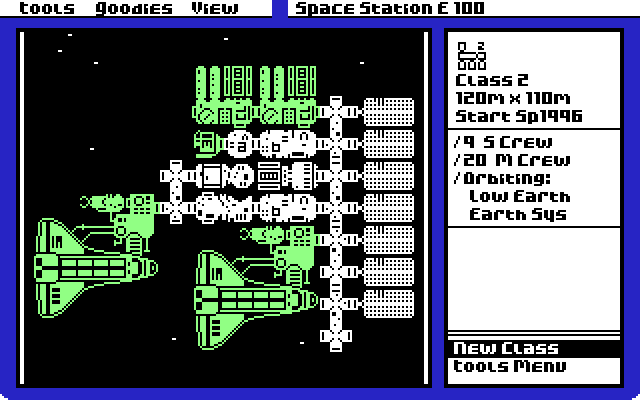 I'm starting to run out of space, but it's not time to switch to research just yet; remember that I can buy a second station if I pay off my loan and have 250 credits in the bank. With that in mind, I set 26.2 for the Weather Center, 41.0 for the Computer Labs, and 87.1 for the Shuttle Port. I hadn't brought it up yet because I wasn't expecting berryjon to start researching so soon, but there are two modes you can put modules into when they're researching. In Enhancements mode, they slowly but steadily do research. Breakthroughs mode can produce four times as much research... emphasis on can. I don't know which pays out better over the long term, but in the short term - well. Berryjon, do you want to roll the dice or not? Once you decide, I'll process the turn.
|
|
|
|
berryjon posted:The way my luck is going? Can I split the difference on the Labs, or go all in? If it's all in, Let's roll the dice this turn. All modules of a specific type have to have the same setting, but different types of modules can be set differently. You can see the AI's settings (though at this point they're purely hypothetical) on its module summary.  And speaking of! 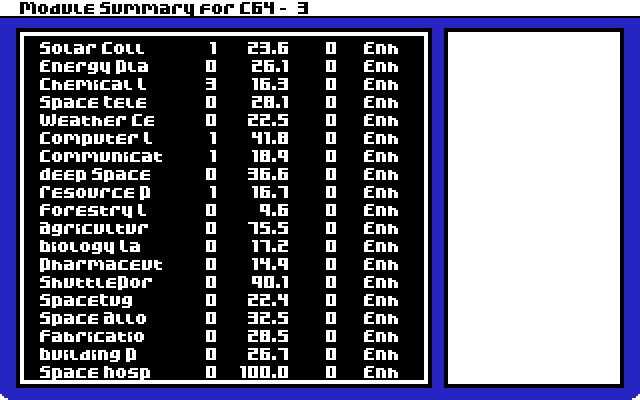 Compared to my predictions, the AI is bullish on the Pharmaceutic Lab and bearish on the Weather Center and the Resource Platform. Everything else was within 10% of what I would charge. And now, the news:
 My Weather Center and Shuttle Port modules have 100% usage, and my Computer Lab modules have 98% usage. It appears the hypotheses I've been operating under about module demand is correct: module demand (a) is an average of the demand for all the activities it produces and (b) isn't actually 'demand' but is a multiplier, or close to it, to get from base charge to ideal charge. (Which is to say, building two Shuttle Ports didn't mean I had to charge half price for each; I could have as many Shuttle Ports as I could cram in and still collect full price on the Transport market.) 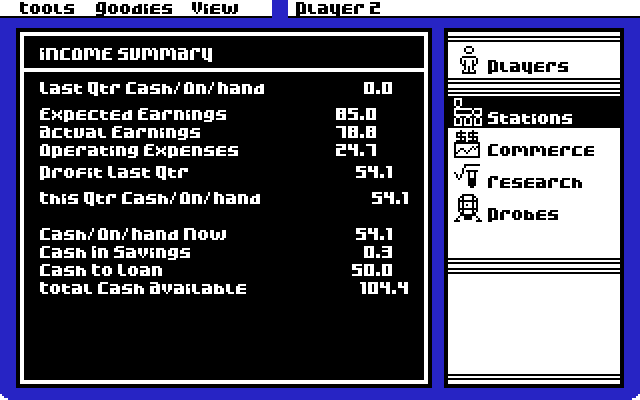 Berryjon, meanwhile, saw 93% Solar Collector usage, 90% Communications usage, and 94% Resource Platform usage. He also saw his Pharmaceutic Labs produce, well... 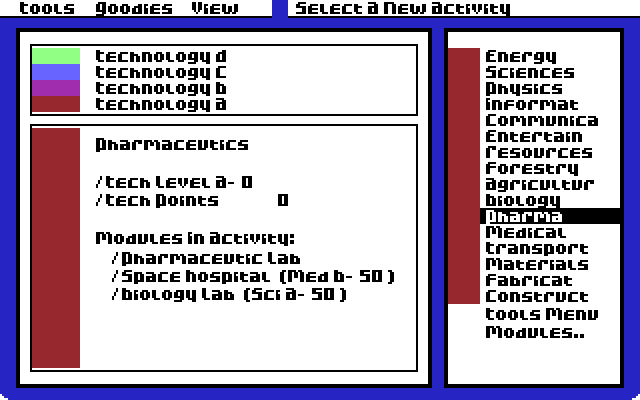 As I understand it, you tech up in activity from A00 to A99, then from B00 to B99, and so on. I'm not sure when you get tech points exactly; my testing earlier showed it's not a one-to-one relationship, but not what the actual ratio is. At certain points you can unlock new modules; for instance, at Medical B50, you unlock the Space Hospital, which is a cargo module you use to construct the titular station. More on that when it's relevant. Oh, and in case you were wondering: no, berryjon, you didn't generate any Medical research either. This isn't your lucky run. That said, not spending anything for a quarter did save you enough money to bolt more stuff on. As for me, the rich get richer. With my 247.4 available cash, I get pretty much the same results from nostradamus, perform pretty much the same station cost analyses, and, speaking of cramming stuff on, get: 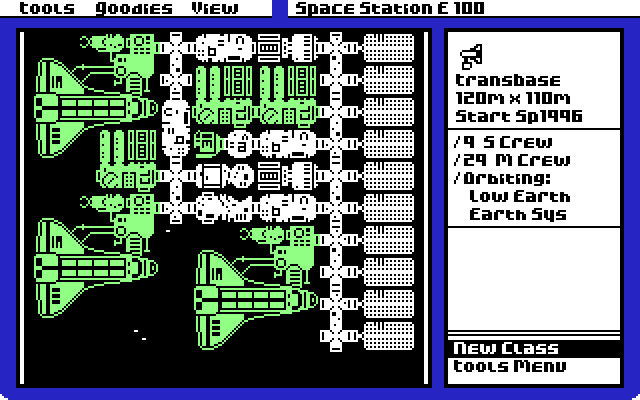 Well, hello, another concept I didn't expect to have to explain this mission! You'll note my station is now classed as a Transbase, complete with new icon. (Previously it was a Class 2 station.) What do station classes mean? Well, here's the rundown, and the reason this update took over four hours to make:
|
|
|
|
berryjon posted:This is turn 5, right? Correct, turn five of eight. Which means it's time for me to start thinking about my endgame strategy. But first, your move. Note: the Weather Center's cost increased to 18.7 last turn, and the Solar Collector went up to 66.3 during turn three, so you only had 11.4 available cash remaining. Here's a list of the relevant cost changes; there were no changes this turn.
 Here's your improved station... 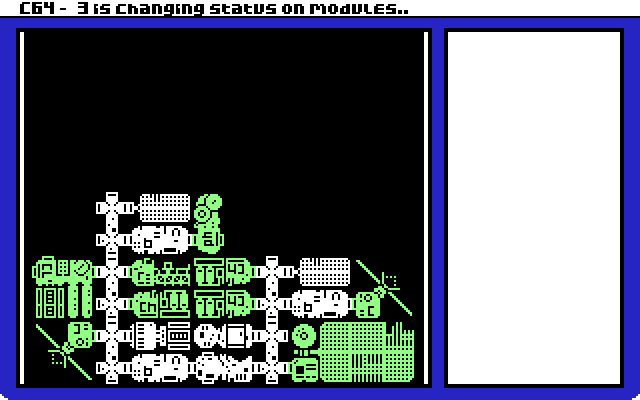 ...and here's the AI's.  Compared to the AI, I was optimistic about the Weather Center and Resource Platform and pessimistic about the Pharmaceutic Lab. Let's see who was right. But first, an odd item in the news: 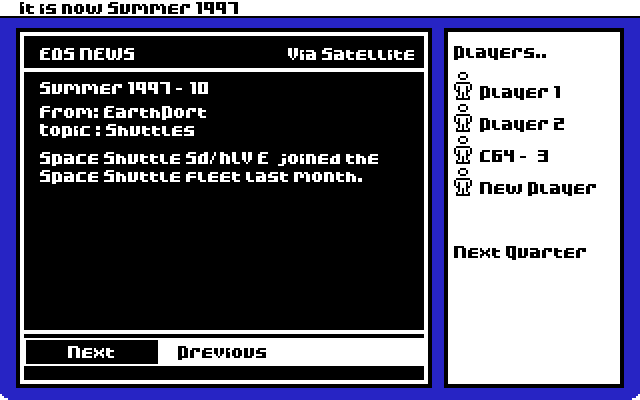 How do you pronounce that, exactly?
... Agriculture starts falling the moment berryjon buys a Weather Module. Berryjon, are you cursed? 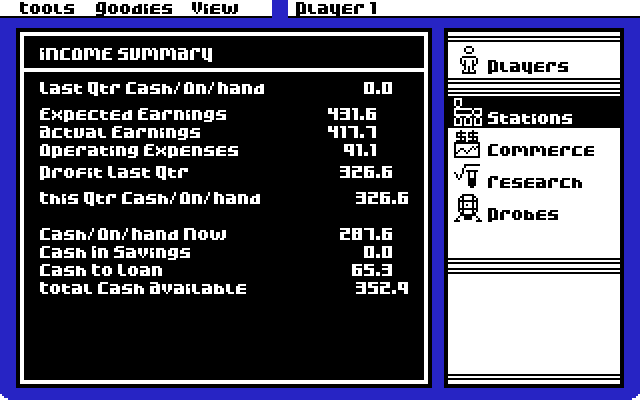 Oh hey, my loan limit has gone up! Get your income high enough, and the bank starts trusting you with more money. And I have enough cash on hand to start a second station... 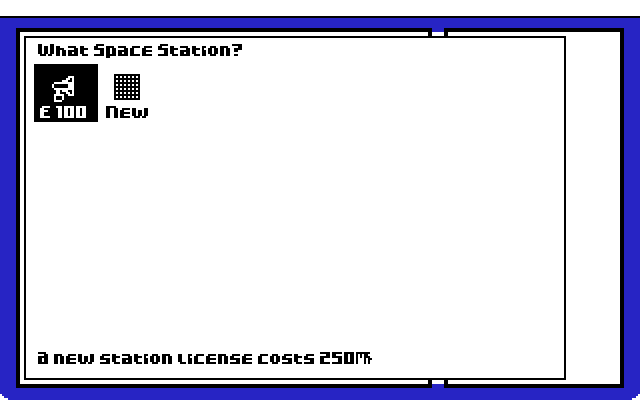 ...which answers my earlier question, as well as another question I had. You have to pay 250 credits just to start a new station, on top of whatever modules you want. Good to know. It's time for me to start thinking about the end game. I've been evaluating the desirability of modules based on how long it takes to pay off the associated widgets; a widget that pays for itself in one turn is better than one that pays for itself in two. (I went into this in more detail when describing how I planned my first turn.) However, I now have to consider whether a widget will have time to pay itself off. The Pharmaceutic Lab, for instance, I currently estimate will take over ten turns to pay itself off - which is six turns more than I have. It could still be worth buying a module that won't fully pay itself off by the end of the mission, if I could generate more research with it than with modules that would, but it's something to keep in mind. I have 352.9 credits available and very limited space to work with. With three Computer Labs and a Weather Station, I'm over halfway to completing the requirements for the Science Lab Station; I'd like to finish doing that. 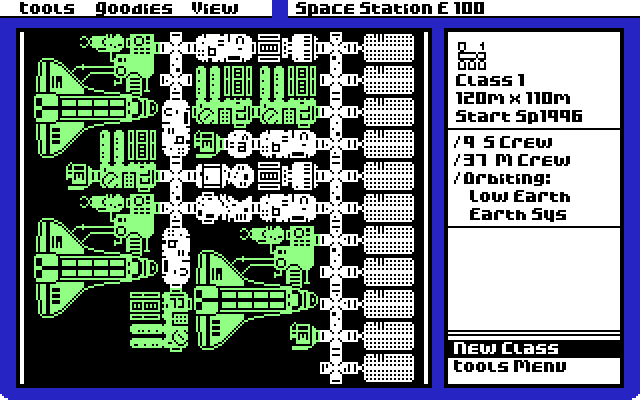 So I do. (Since it also qualifies as a Transport Base, it's now a Class 1 Station.) Once I pay off my debt, I still have 175.3 credits, which I stick in the bank. (Technically, I'm not out of building space yet - there's a connection on the south end of the new Computer Lab and one on the west end of that Short Connector - but I wanna see if I can squeeze in a second station before the end of the mission.) I also lower my charge on the Weather Center to 29.8 (that ding in the Agriculture market has me worried), but raise my Computer Lab charge to 45.9 and my Shuttle Port charge to 91.8.  Berryjon's module usage was:
 And his two Pharmaceutic Labs produced an enhancement, which put him at tech level A02 in Pharmaceutics and A03 in Medical! Unfortunately, this isn't enough to earn a single tech point, so he isn't winning yet. Berryjon, you have 108.9 credits available. Go. (By the way, when preparing the images for this update, I was running into a weird issue where things that weren't supposed to be transparent were turning transparent. If you see any issues with this or other issues in the LP having blank spots where they shouldn't, let me know.)
|
|
|
|
berryjon posted:I should now have just enough money to do this without going broke. Let's find out. But first, a test. I paid off your loan and put all of your funds into savings, then ended the turn. Your operating expenses were 28.2, and in a news bulletin, I was told that the EOS Bank had issued you an emergency loan to cover those expenses. Interestingly, (a) they didn't charge interest on that loan this quarter and (b) you still collected interest on the money in savings! This is exploitable, I feel, but I don't know what would happen if I tried it; my operating expenses at this point are well above what the EOS Bank is willing to lend me. At any rate, since it did you no harm, I go ahead and accept the results of advancing the turn.  The AI continues to build. 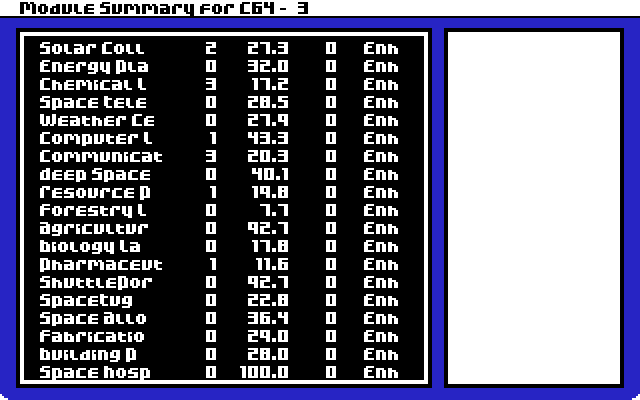 Compared to the AI, I overestimated the demand for Weather Center by 6.9% and underestimated the demand for Pharmaceutic Lab by 14.8% and Chemical Lab by 7.2%. Aside from the news about berryjon getting a loan, three items of note came up:
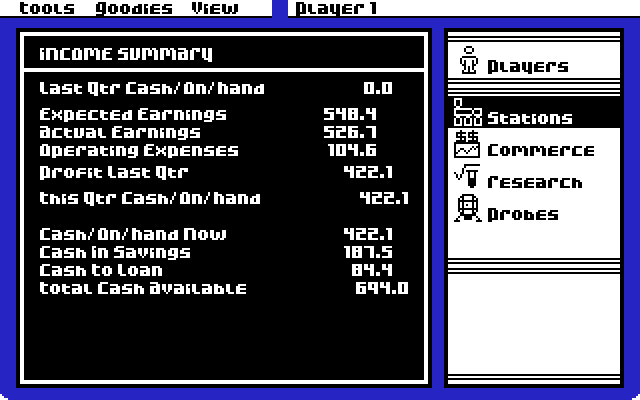 I only got 82% usage on the Weather Center - I wasn't worried enough about the Agriculture market - but I got 97% on the Computer Labs and 100% on the Shuttle Ports. With 609.6 credits without taking out a loan (and my loan limit has gone up to 84.4 credits), I can easily afford to buy a second station license. Of course, I immediately take that loan to fund the construction of the station: 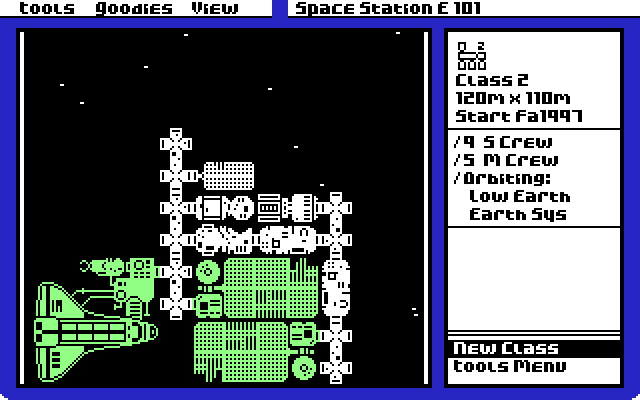 Unfortunately, I goofed the math at some point - I thought I'd be able to build three Shuttle Ports total, but I ran out of funds here. Ah well. I set the Weather Centers to 27.0, the Computer Labs to 50.7, the Shuttle Ports to 94.2, and my brand-new Solar Collectors to 30.6, though I mainly threw them on for a bit of extra research at the end. 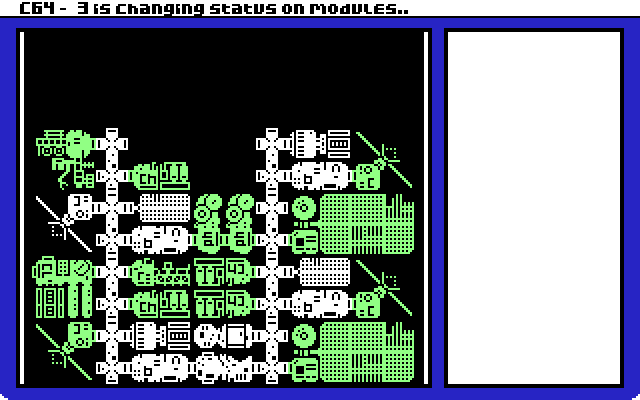 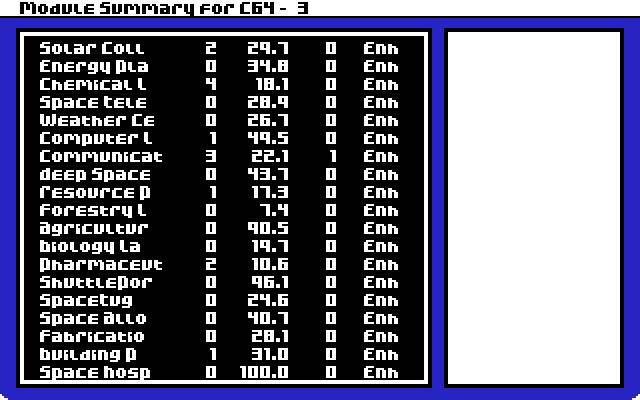 The AI is starting to put modules into research mode as turn seven starts. ...or is it turn eight? The calendar says Winter 1998. In a moment of paranoia, I check my previous updates as well as the manual. ...son of a bitch! The scenario started in Summer 1996, where the manual said Spring 1996, and it supposedly ends in Spring '98! I mean, I could back up my poo poo and advance a quarter, see what happens, but you know what? It's a victory lap at this point. I'm going to throw on those two Shuttle Ports I wanted -  - throw everything into research mode, and pull the handle. If I'd known this was coming, though, I'd have tried to plan it so I could have spent every last dime on researchy stuff. As it is, I'm gonna have nearly 500 credits not making research. 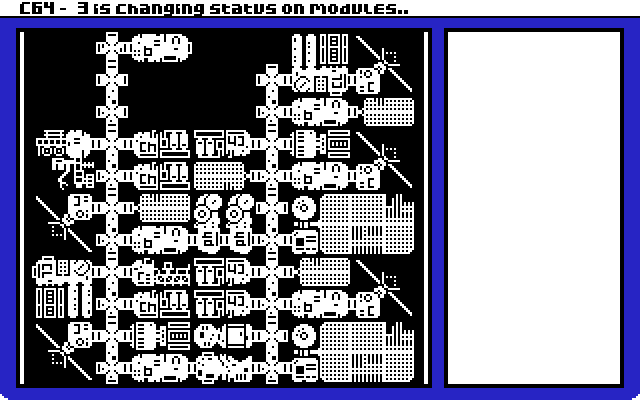 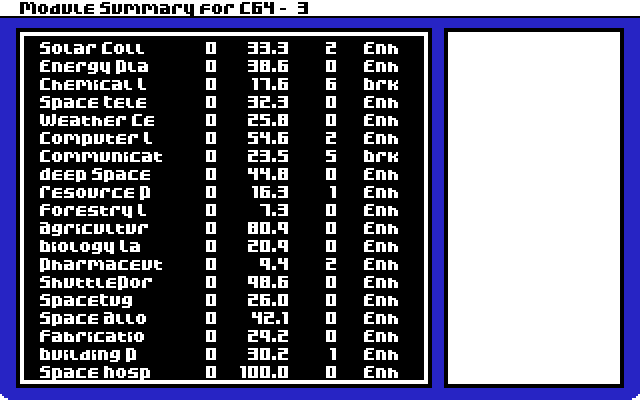 The AI certainly thinks these are the end days. 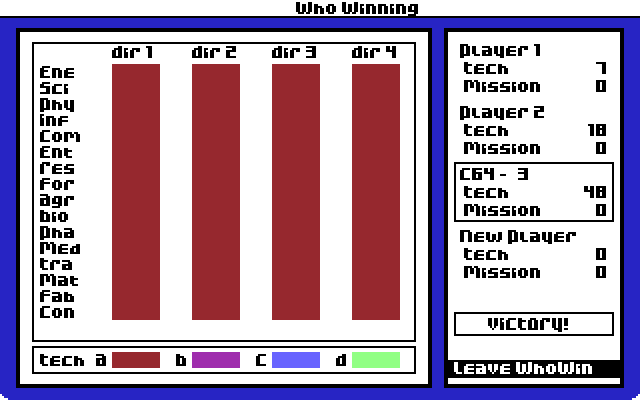 https://www.youtube.com/watch?v=jp9SmaXjovE ...what. The. Hell? Okay. Okay, deep breaths. Where did I go wrong? Well, I got the number of turns wrong for starters, but also: in the end, I had six Shuttle Ports, four Computer Labs, three Weather Centers, and two Solar Collectors running for a single turn kicking out research. I left them all on enhancements (another mistake; I should have set them to breakthroughs and used the Science Lab Station bonus). Shuttle Ports produce Transport activity, Computer Labs produce Information activity, Weather Centers produce Physics and Agriculture activities, and Solar Collectors produce Energy activities. So I should be able to see a direct correlation between the modules and the tech they produced, which is:
Meanwhile, berryjon had his station in full research mode for two turns. He had two Solar Collectors (Energy), one Weather Center (Physics and Agriculture), one Communications (Information, Communications, and Entertainment), two Resource Platforms (Resources, Forestry, and Agriculture), and two Pharmaceutic Labs (Pharmaceutics and Medical). I failed to record his research progress on turn six (another mistake), so I don't know how many enhancements and breakthroughs he got then, but over the two turns he got a total of:
But. Now we know.
|
|
|
|
I've been spending the three hours going over my information on the modules and station classes in the game and making corrections, updating the second post accordingly. I'd like to draw your attention to a few altered entries. Pharmaceutic Lab: "A laboratory used to study and produce exceptionally pure pharmaceutical products." Costs 32 credits to build, two shuttle tons to launch, and 2.5 credits to operate. Uses three crew. Requires ten Power, three Life, and three GGym to operate. Part of the Life Sciences Station. Provides Pharmaceutics and Medical activities at a base charge of 20. The Pharmaceutic Lab is a poor choice for commerce unless both of its markets take off. That said, it's a really good research module. It's compact, it has two attachment points (though their placement is a little strange, making it effectively a 1x2 module instead of a 2x1), and it's cheap to run. Oh, and it's essential for the "Mars Rescue" mission. Underestimate this at your peril.  Resource Platform: "Resource Platforms provide equipment for manned study of Earth's resources." Costs 21 credits to build, two shuttle tons to launch, and 1.5 credits to operate. Uses one crew. Requires ten Power, one Life, and one GGym to operate. Part of the Life Sciences Station. Provides Resources, Forestry, and Agriculture activities at a base charge of ten. One of the worst modules for commercial activities, but one of the best for research. You need Resources research for the last two missions, and this module not only provides Resources research but provides the research you need to unlock the other two sources of Resources research: the Agriculture Lab and the Forestry Lab. Given the Agriculture Lab's poor performance for its size and the Forestry Lab's much better commercial performance, this is still likely to be your primary source of Resources research even once you've researched them. And, most importantly,  Shuttle Port: "Shuttle Ports provide facilities to dock a shuttle to a space station." Costs 77 credits to build, four shuttle tons to launch, and 9.5 credits to operate. Uses five crew. Requires 70 Power, five Life, and five GGym to operate. Part of the Transport Base. Provides Transport activity at a base charge of 74. The second best commerce module overall, and the best you don't need to research for, so long as the Transport market doesn't tank. But it carries a terrible cost: its research efficiency is the worst in the game, due to its huge size and huge costs. Just use it to make money, you say? Well, here's the thing: you need Transport research to build several mission-essential modules starting in the fourth mission, and the only other source of Transport research, the Space Tug, itself requires a full level of Transport research. This shining seagull quickly becomes an albatross. Note: the two station tiles next to the Shuttle's cockpit on the right are not part of its hit box. So yeah. Going whole hog on those Shuttle Ports crucified me when it came to the end game, and I'm going to have to spend some time on that cross every mission starting with the fourth. I'm probably going to take a day off the LP, but I'd like to see if there's any more interest in people joining in now that we have some more idea of what we're doing - if only by counterexample - than we did when we started. If you're interested, but it seems daunting, ask your questions, and I'll try to provide answers! I'm also considering not playing all seven missions in the LP, because they're only going to get longer. The remaining missions are:
Oh, and berryjon, regarding your offer: berryjon posted:Proposal: Fred and I abuse the hell out of the 'Trade' system to team up and beat 2 AI opponents. Running a station purely for profit is, I feel, largely a solved problem at this point. I can improve my market model, but once I know what I expect demand to be next turn, I almost literally push a button and get told what to build. (And with a bit more work I could make that actually literally.) Having been schooled in how research works, I also believe I could run a pure research station 'properly'; I just change the metric of what to buy from 'makes its cost back most quickly' to 'generates the desired research most efficiently for the money and space'. The thing I don't know yet, which is therefore the fun bit, is how and when to properly switch between the two. That said, if you want to do something more cooperative, we have options. For instance, in the 'Shuttle!' mission, we could try to get our lowest score higher than the AIs' highest; we'd both have to do commerce and research, but if one of us falls behind, the other would have incentive to catch them up. I might have other ideas after a good night's sleep. FredMSloniker fucked around with this message at 16:19 on Jun 6, 2021 |
|
|
|
berryjon posted:I think that we should do Dry Dock as it will help show off specialization of stations, and having multiple stations. If you wanted to do that co-op, I think the best solution would be for us to run a single company. We'd have to be careful not to cede the interesting bits (namely, figuring out how to split growth activities, research activities, and winning the mission) to one of us, so there'd be some back-and-forthing. Or we could try to beat the AI on the same turn, meaning our companies would have to support each other in a three-legged race. Or we could compete again, this time without the sucking. I'm holding out hope that someone else will want to play too, though!
|
|
|
|
If you want to take part, I can polish the code I'm using and send you a program where you plug in what you think the market will do next turn and what you want to accomplish and have it tell you exactly what to build. I automate that part myself, and I see no reason not to share it for the sake of a more interesting LP. I can even give you some advice on predicting the market, though of course I won't share my exact prediction model.
|
|
|
|
The offer was meant more for anyone else who wanted to jump in on this LP but was hesitant about the complexity. You beat me in the last mission; you don't need the help.  On a more serious note, I'm kind of concerned about the viewership of this LP. These are all the posts that aren't by me or berryjon: Gideon020 posted:I will admit, an LP born from spite was not something I expected, but somehow feels particularly Goon-y. Kangra posted:I played Project Space Station a lot, and I always wondered what EOS was like, so I'm interested in following this. AtomikKrab posted:This game makes me think of how loving idealistic we were about space just in the 1990s, we were gonna DO poo poo... and we don't After The War posted:Argh, I'd forgotten how badly the Station Power and Solar Collector modules make me want Chex mix. Veloxyll posted:So is each mission self contained? Or do you play the same company throughout all of the missions? Because I can see tanking the first mission to win harder later on with your disgusting economy seems like it'd be a legit strategy Kangra posted:For some reason I think PSS had a refitted Enterprise orbiter as well, though I may be misremembering. Kangra posted:Yes, the shuttle piloting minigame was one of the best parts, but I'll hold off discussion till the potential LP of that game. (I think I also recall that you don't really do stuff for the ESA so much as bid on contracts that they'd otherwise take.) habituallyred posted:This is cool to read about, but way too complicated for me. That's nine posts out of 64 and less than 2,000 characters. Am I setting my expectations too high? Am I doing something wrong that's discouraging thread participation? Is there just not a lot of interest in the game? I'm willing to keep things going as long as someone is interested, but I'd really rather it be more than someone.
|
|
|
|
Woo! A third participant! I'm working on improving the tools I've been using to be as easy to use as possible; once I'm done, I'll throw them up on a Google Drive and everyone can download them or not at their pleasure. (Please be aware that the interface will be rather primitive. Also be aware that you'll need Lua installed; if that's a deal-breaker, let me know what OS you have and I'll see if I can compile something for you.) Once the tools are ready, I'll also start the Dry Dock mission. While I work, though, let me fill you in optional rules. There are three of them, and this mission introduces two, but you can turn them on or off for any mission.
Decoy Badger posted:The infodump in the OP was very intimidating to me. I'm working on improving the OP as we speak. The second post is going to have to stay an infodump, but I'll try to organize it better. I'm also going to be removing negativity from the first post, as I'm over it now and it may be turning potential readers off. Decoy Badger posted:Also it's like a puzzle game but with a lot of RNG thrown in which honestly doesn't sound like a good game design decision since it effectively punishes meticulous min-maxing. There's RNG, but not as much as you might think. By and large, I was able to predict what the market did, and the occasional market hiccup will only hurt those who predicted less accurately. Decoy Badger posted:Watching the first round helped a lot, I think if you had some kind of tutorial mission or run-through it would have helped a lot with participation. Yeah, I guess... consider the first mission the tutorial? I'll bring that up in the OP. Decoy Badger posted:His ultimate goal is to make a space station shaped like a giant robot version of himself, which will then transform and fly to Pluto. You'll be pleased to know that Pluto (a) is in the game, (b) is still a planet, and (c) is a valid Settlement location, as is Charon.
|
|
|
|
I've improved (I hope) my first two posts in the thread. I also discovered something interesting while looking at screenshots: before we started having technical difficulties, the "Research" mission started in Spring '96 as it should. It was only on our final run that it started in Summer '96. Before I start the next mission, I'll have to make sure I haven't somehow borked the mission disc. (I did copy it as instructed, but maybe I need a fresh copy?)
|
|
|
|
It may be a few days before I start the next mission; I'm still working on improving my LP tools, as well as other routine RL stuff. I'll keep you up to date.
|
|
|
|
berryjon posted:You see, there's one thing that I think Fred missed in their planning and that the end goal of the scenario isn't money, it's research. So for the last turns, I drove my finances into the red, and set everything to Research. Fred got the memo a turn too late, and pulled his switch after me. But I had just enough of a head start to pull ahead of him, though had the scenario gone on even one more turn, his weight of modules might have let him catch up to me. I didn't miss it. I misunderstood the way research worked and thought that, the higher a module's base charge, the more research it could produce. My plan was to spend nearly everything on the second to last turn building as much as possible, then switch it all over. Unfortunately, (a) I got caught out by the unexpected end of game and (b) thanks to my misunderstanding, thought I was going to win anyway, so didn't bother buying a bunch of stuff to put in research.
|
|
|
|
Me: "Man, it's hard work having to pull every screenshot into GIMP, crop it, make the corners translucent, save it again..." Also me: (spends hours using minimal Python knowledge and a PNG module grabbed online to write a program that will do it for me) 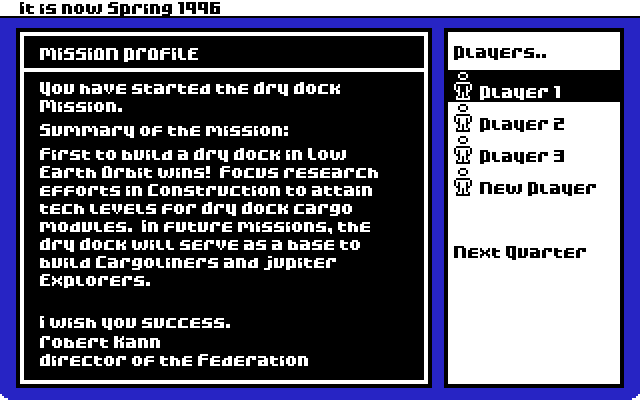 No AI player this time; I doubt any of us want to find the game suddenly over because the computer beat us to it. We might have AIs on future, time limit-based missions. I didn't find the news too useful last game, but maybe I wasn't paying close enough attention. In the interests of presenting all available data to aid your decision-making, here it is:
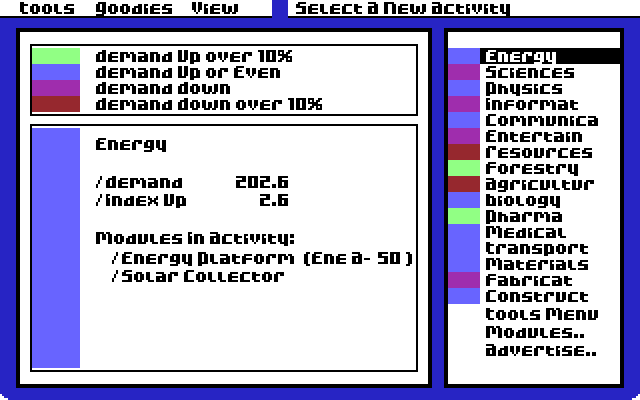 Note the new option at the bottom. As previously mentioned, this mission introduces advertising. Personally, I don't think it's a good idea to use it - worst-case scenario, everyone spends 500 credits for everyone to have permanently reduced their usage percentages by 50% - but that doesn't mean I won't retaliate if attacked. Don't start none, won't get none. The first-turn market changes are:
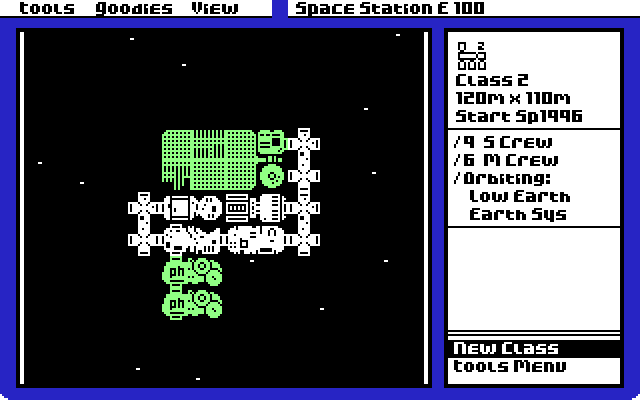 For now, I'm focusing on growth. I like the look of the Pharmaceutics market, so I'm grabbing some of that, and I'm using a Solar Collector mainly because it's something, commerce-wise, and meets my power needs for a while. I'll charge 34.1 for the Pharmaceutics Labs and 20.5 for the Solar Collector... unless one of you yokels gives me reason to do otherwise. Berryjon, you're player 2; Decoy Badger, you're player 3. There's still time to join as player 4, though not a lot. You each have 200 cash on hand and 50 in potential loans. Have fun! Oh, and those tools I mentioned aren't quite where I want them to be yet - they do what I want, but they're not bullet-proofed or anything - but if you want a tool that, given your predictions for market demand, suggests what to build next, just let me know.
|
|
|
|
Decoy Badger posted:
You do that picture manually, or you hack a program together? Either way, it looks nice. More precisely, it looks like this: 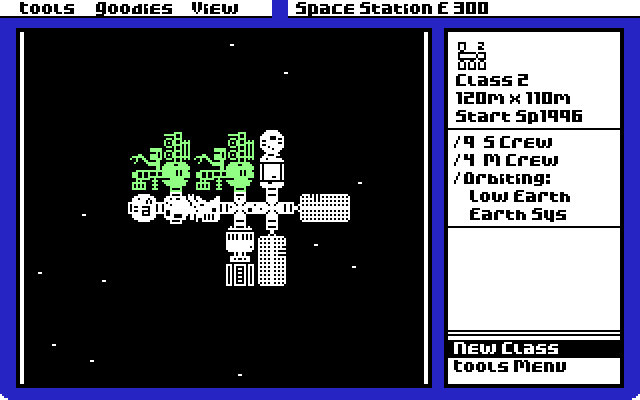 I can put together a pack of the images as used in Appendix F, i.e. without the outlines I use in the LP images, if you like. Actually, some sort of 'turn your station design into a pretty picture' program isn't a bad idea.  You have a lot of funds left over, though. Might I humbly suggest you consider investing it in growth opportunities?
|
|
|
|
berryjon posted:Shuttle Port (1,8 through 2,7). Connection to COMMA at 3,8. 77 Credits The Shuttle Port is shaped like this: ...## .#### .#### +#### Where the + is the connection point. Please advise. e: for clarity, the + is not part of the Shuttle Port, just the place on the Shuttle Port where it can attach. See also: 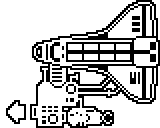
FredMSloniker fucked around with this message at 06:39 on Jun 11, 2021 |
|
|
|
berryjon posted:Bah, that's what I get for doing it when I should be going to bed. I'll need to buy another Long Connector, but here: Done.  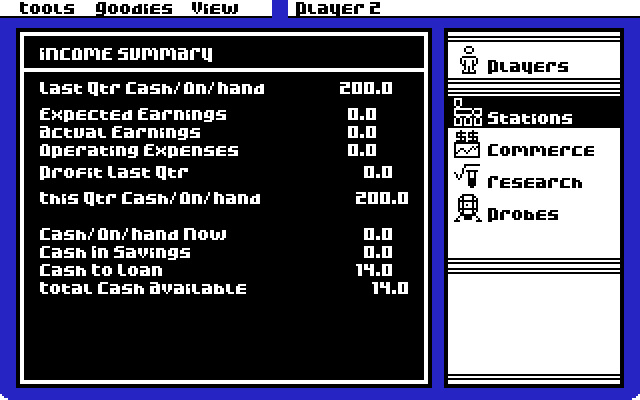 Just waiting to see if Decoy Badger wants to build anything else or not.
|
|
|
|

|
| # ¿ May 22, 2024 12:25 |
|
Decoy Badger posted:Revision: Set one building platform to breakthrough research, the other continues to charge 26.5. All right. Here's the news, and there's a lot of it:
As for the market...
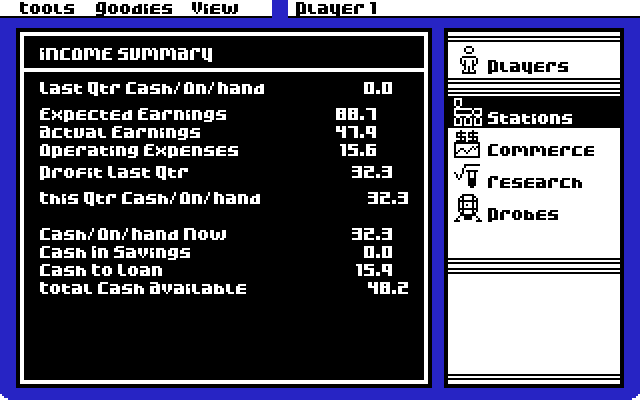 I saw 98% usage of my Solar Collector, but only 41% use of my Pharmaceutic Labs, thanks to that market unexpectedly tanking. As a result, I'm 40.8 credits down from where I expected to be, which is going to hamper my growth. 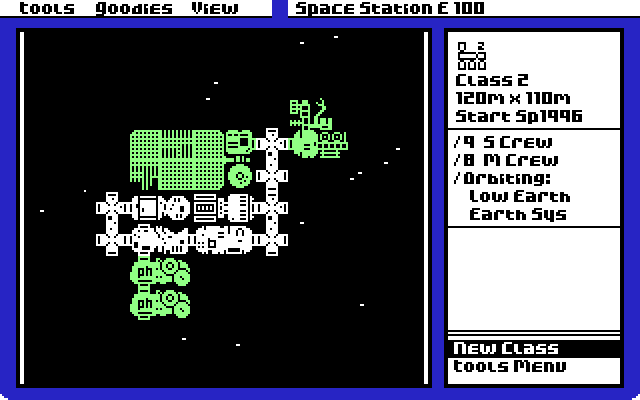 That said, I do have enough to put a Building Platform on. I won't start researching with it just yet, though; as I said, I'm still in growth mode. It just happens to be a good investment right now. I'll charge 27.5 for it, a mere 26.2 for my Pharmaceutic Labs, and 20.8 for the Solar Collector. 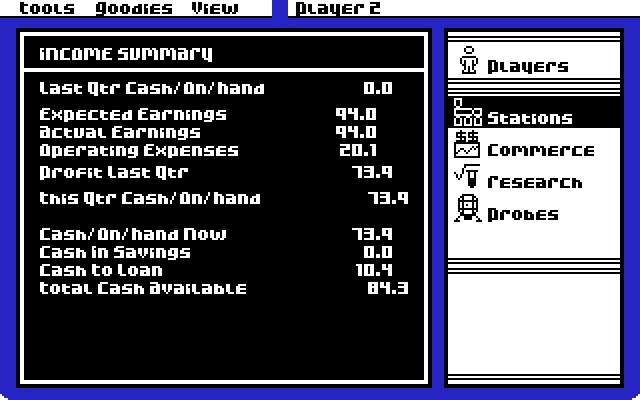 Berryjon got 100% usage out of his Solar Collector and Shuttle Port both, which doesn't surprise me; I would have charged more (and I did charge more for the Solar Collector). So he's right where he expected to be. 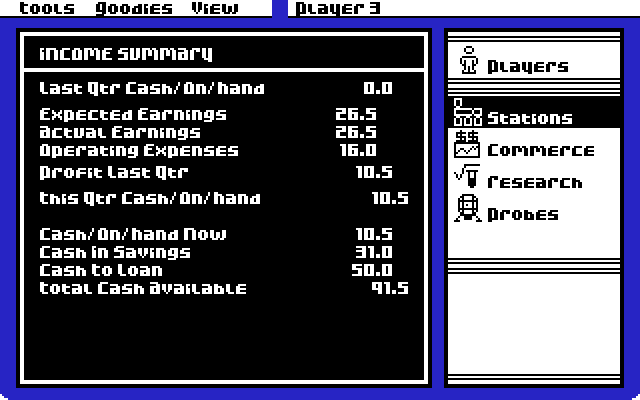 As for Decoy Badger, he gets 100% usage out of his sole commerce mode Building Platform...  ...and no research breakthroughs this turn. Your move!
|
|
|








